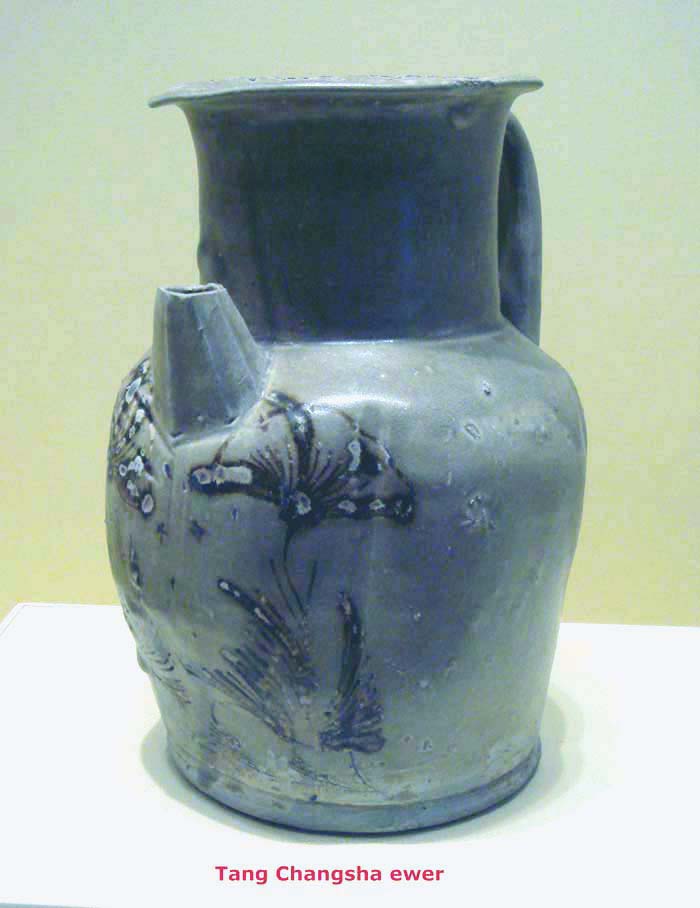
Tang/5 Dynasties Porcelain
The Tang period firmly established the following dominant porcelain production trend: Greenwares in the South and White wares in the North of China (南青北白). Yue (越) and Xing (邢) wares represented the best green and white ware respectively. However, it must be noted that some greenwares were also produced in Northern China kilns. So far no kiln that produced white wares during the Tang period was found in Southern China.
During the Tang Dynasty, porcelains with painted design to enhance their aesthetic beauty were further developed by the Chinese potters. Iron, copper oxides and to a lesser extent cobalt were the pigments used to decorate high-fired wares. The most important contributors were the Changsha potters who used copper/iron oxide to paint green/brown motif. They were also among the earliest to use copper oxide to create high fired copper red decoration. Before Tang, copper oxide was used only for lead glaze green low-fired pottery wares/

Interest in painted porcelains appeared to dwindle during the 5 Dynasties. Porcelains with iron-brown decoration for royal use were produced in Yue kilns during the 5 Dynasty but the volume of production was small. Underglaze iron-oxide painted black/brown motif on porcelains finally became a main-stream product for the common folks during the Song Dynasty
Experimental underglaze painting using cobalt on porcelains were initiated by the Gongyi (巩义) [previously called gongxian (巩县)] potters of Henan province. Blue and white wares were produced for the middle east market and interest was short-lived. Production only resumed during the Yuan Dynasty and interestingly, the main market was again the Middle East.
Another important new product was black glaze wares with opacified bluish/white splashes. Th most important kilns producing such wares were Lushan Duandian (鲁山段店)and Jiaxian Huangdao (郏县黄道) in Henan. Some ceramics experts were of the view that it inspired the later purplish/red splashes on Jun wares.
Porcelain wares were important export items during the Tang Dynasty. Xing, Yue and Changsha wares achieved international fame. They were exported via the overland silk road and maritime trade route to West Asia/Middle East and maritime trade route to Southeast Asia. Besides silk, porcelain was the most important trade item through which the foreigners came to know about China.
 |
| Tang Changsha shards found at a site in Guangzhou. Guangzhou was an important internationa port that served Southeast Asia and East Asia and Middle East. |
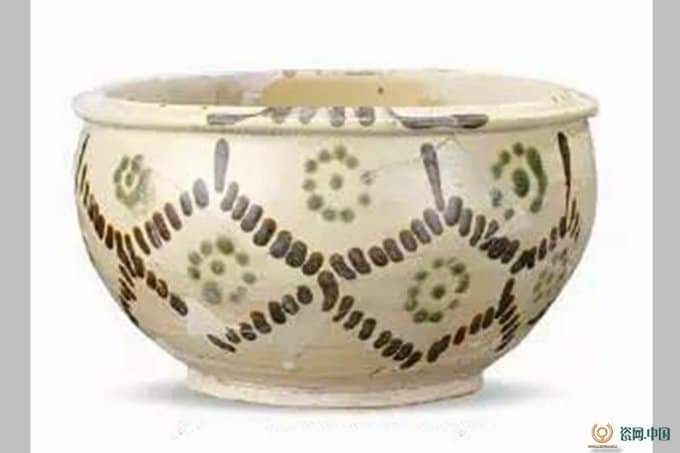 |
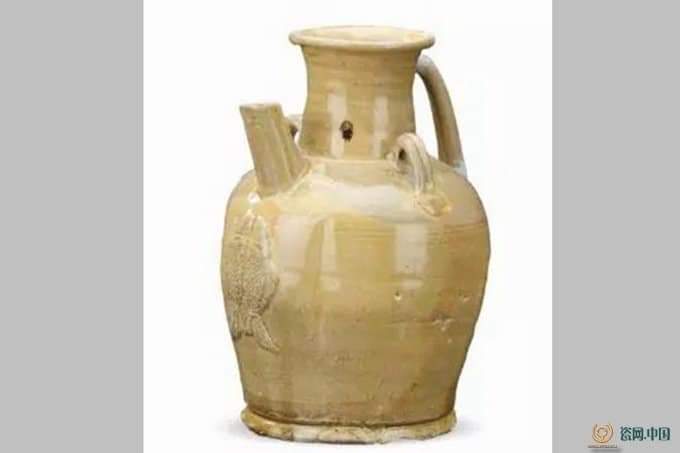 |
 |
| Some Changsha wares found in Yangzhou, another important Tang international port. |
Yue greenware
Zhejiang was the most important greenware production province since the Shang Dynasty. The transition from proto porcelain to actual porcelain took place there during the late Eastern Han period. By the early 9th century, Yue wares showed marked improvement in quality. By the late Tang period, Yue wares was a major brand with an international reputation. The production centre was at Zhejiang Cixi Shanglin Lake (慈溪上林湖).
The glaze of Tang Yue ware has a jade like quality. The shape of vessels are elegant with clear influence of gold/silver wares of the period. Use of decoration was minimal and usually consisted of carved/incised floral motif.
A good glimpse of the type and quality of Yue wares of this period could be found in the Belitung shipwreck. The Belitung shipwreck is dated to A.D. 826 based on a Changsha bowl with a date of 2nd year of Baoli. The form of the vessels are elegant and potting rather thin, with some showing clear influence of gold/silver wares. Decoration using the curved/incised method was used by then. The glaze has a smooth and fine texture and colour is a pleasant pale grey greenish hue.

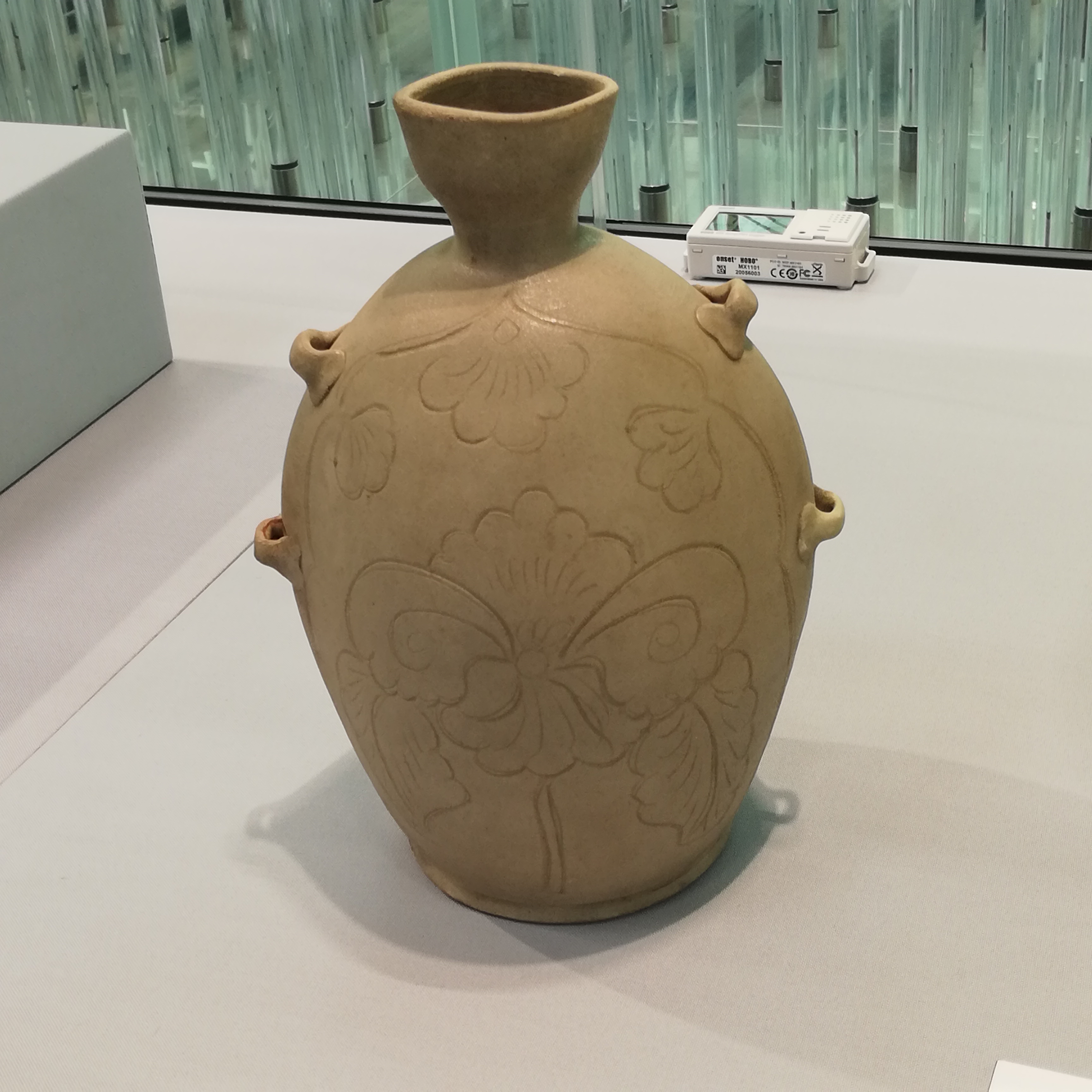 |
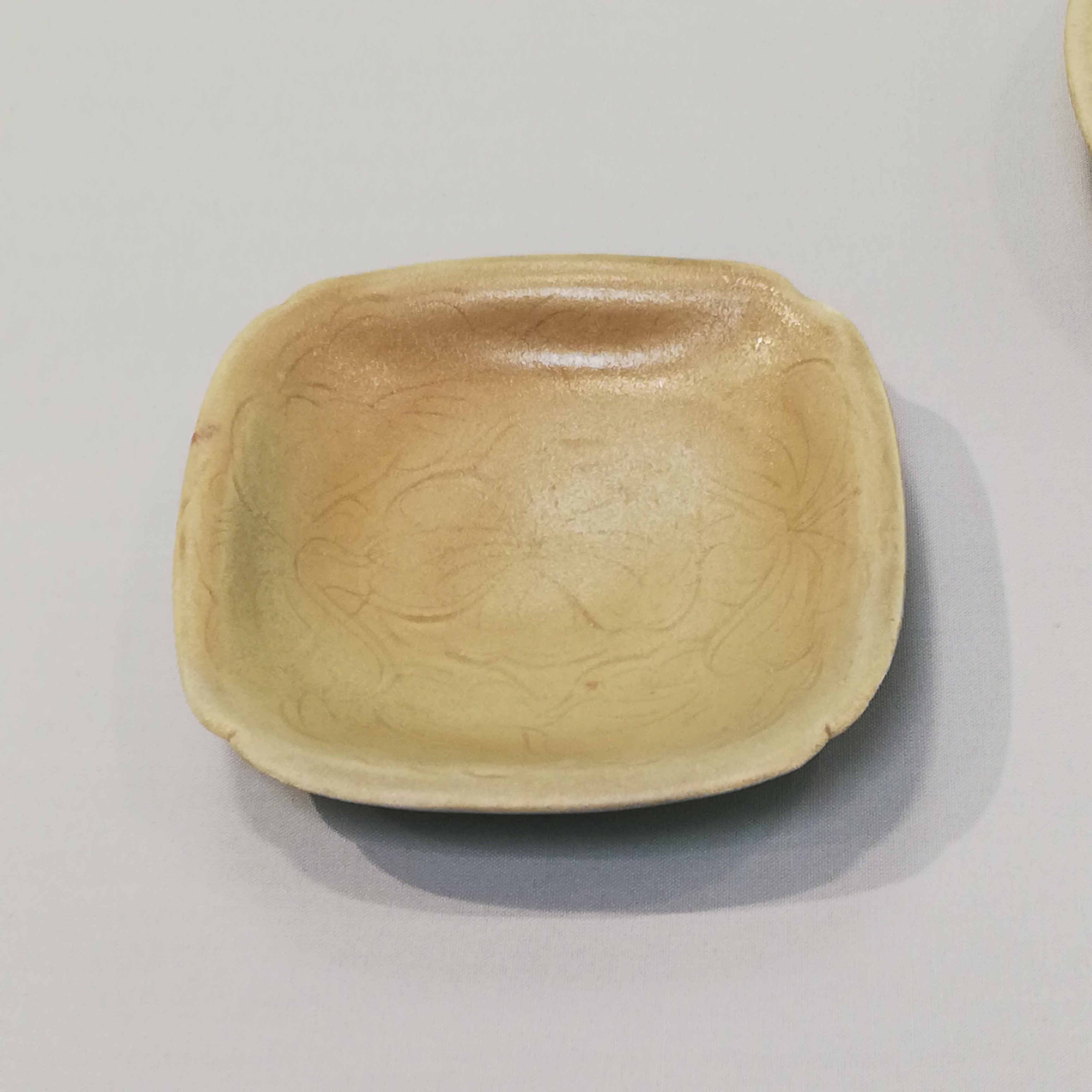 |
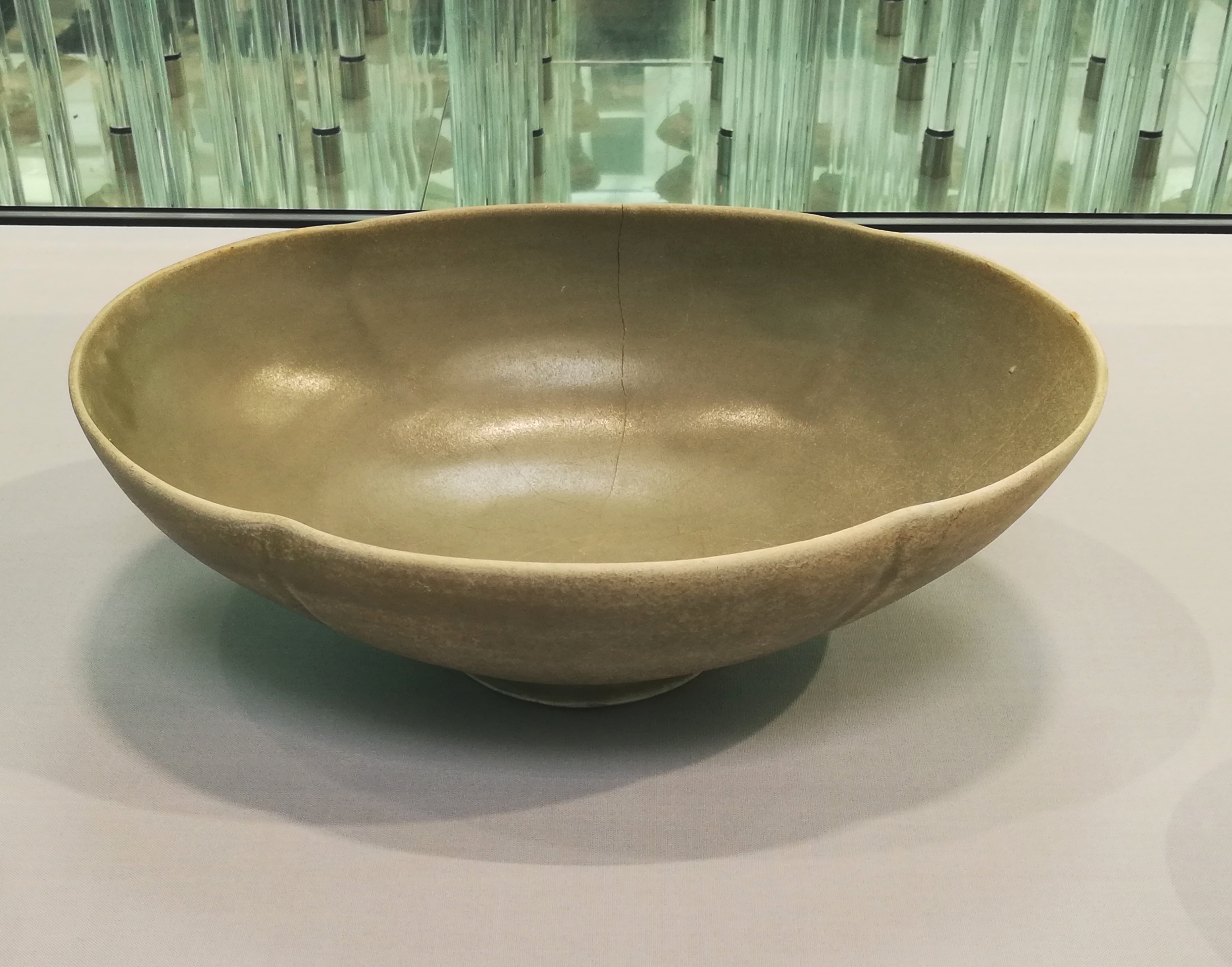 |
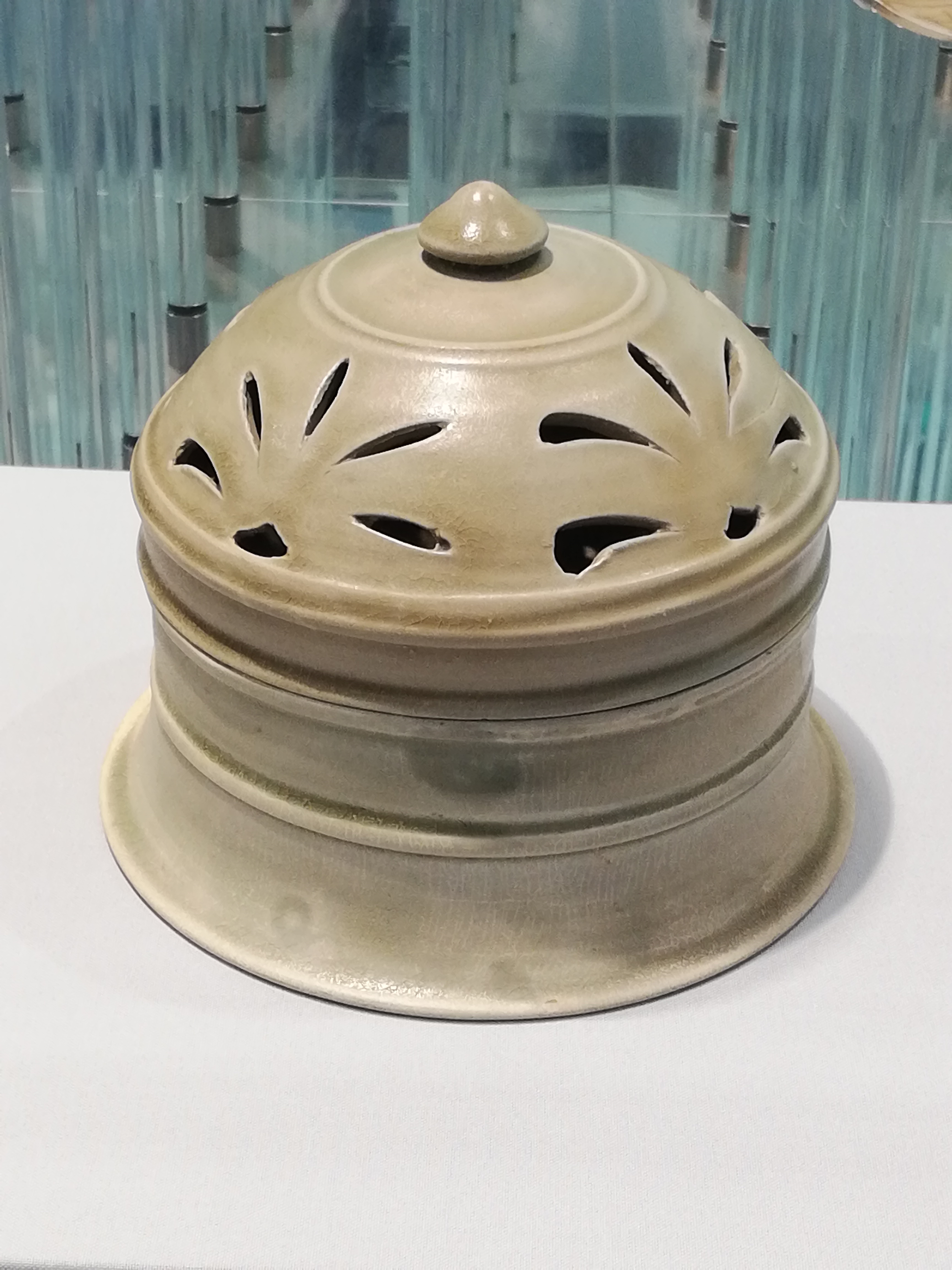 |
| Some Yue wares recovered from the Belitung wreck. |
It was also around the mid or slightly later 9th century that the term Mise was used to describe the top quality Yue wares. Lu Guimeng (陆龟蒙) (died A.D. 881) in his poem "秘色越瓷" Mise Yueqi (secret colour Yue ware) mentioned that Yue wares were fired in misty and windy autumn and described the colour of yue ware as "green from trees despoiled from thousand peaks". The Yue vessels found in the basement of the Pagoda at the Famen temple (法门寺) represented the highest achievement of the Tang Yue potters .
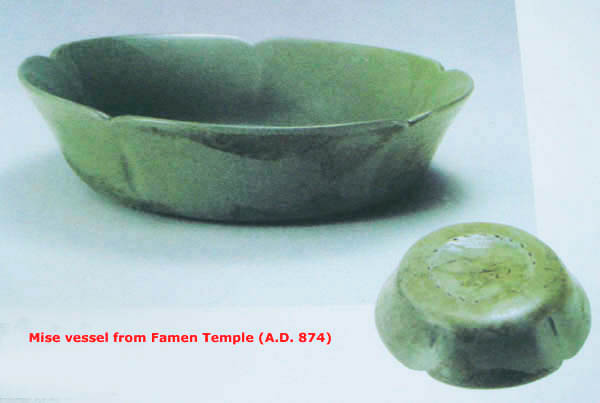
Yue wares of 5 Dynasties and Early Northern Song period is characterised by decorations executed using finely incised lines. The motifs were varied including human subject, paired parrots or parrots, dragon, flowers and etc. Best examples could be found in the Cirebon shipwreck. The ship carried a large quantity of more than 300,000 Yue vessels and many are decorated with incised motif. It has a bowl with a "戊辰徐记烧" Wuchen Xuji Shao " mark, ie. A.D. 968. (The Northern Song Dynasty commenced from A.D. 960, but Wuyue state only relinquished its sovereignty in A.D. 978).
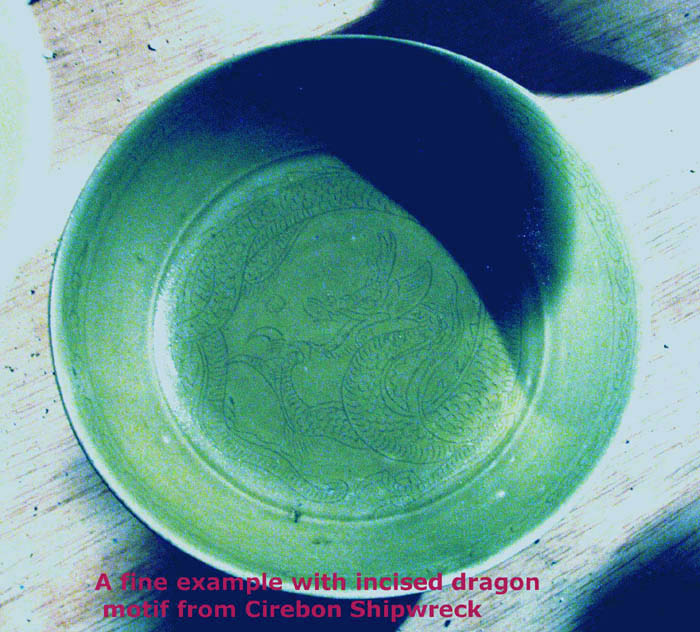
During the 5 Dynasties, there were also some Yue wares with iron-brown motif being produced. They were mainly made for the wu-yue royal family.
 |
||
| Tang Censer with iron-brown painted decoration. From the tomb of Shui Qiu Shi. |
For more information, please read this: Tang/Song Yue ware .
Other important Tang greenware production sites
Besides Yue kiln, 5 other green glaze production sites wo other important celadon production sites were mentioned in Lu yu(陆羽) in his Treatise on Tea (茶经). Those from Zhejiang Wuzhou kilns possess many physical characteristics similar to Yue ware. Archaeologists in China is still unable to locate Dingzhou kiln. The other 3 are Shouzhou kiln (寿洲窑) in Anhui Province, Yuezhou kiln (岳州窑) in Hunan and Hongzhou kiln (洪洲窑) in Jiangxi Province.
Anhui Huainan Shangyao Zhen (安徽淮南上窑镇) was the production centre of Shouzhou wares. kilns (寿州窑). Shouzhou kiln produced a form of distinctive amber/yellow colour glaze induced under oxidation firing atmosphere. This was a sharp contrast to the prevailing preference for green glaze colour. However, it was an astute product differentiation move which was successful and made Shouzhou the market leader of this line of product. In view of its popularity, other kilns in Henan and Hebei also produced such wares. The paste is coarse and ranges from whitish, whitish red to reddish. There is a layer of white slip applied on the body before glazing.
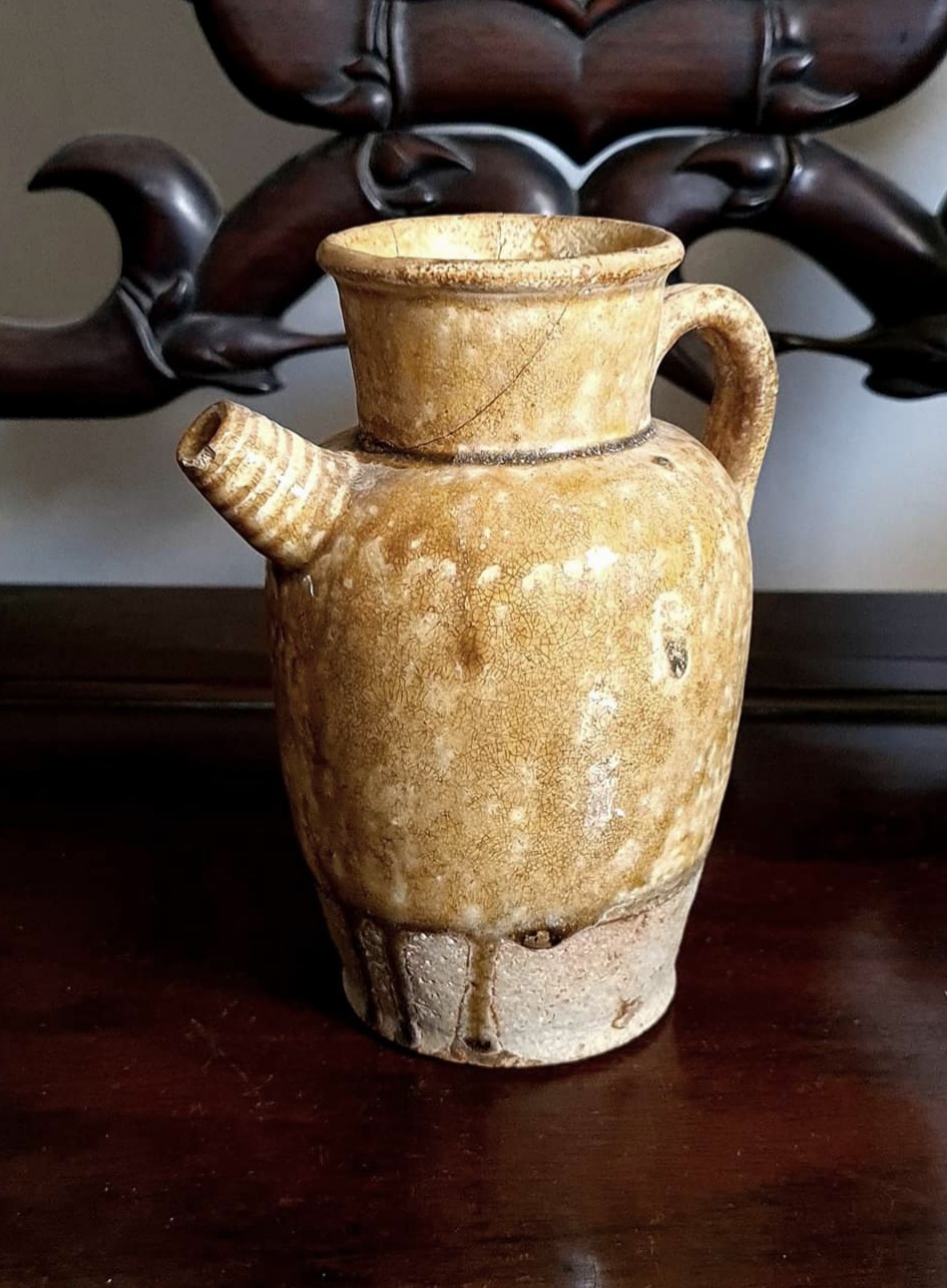 |
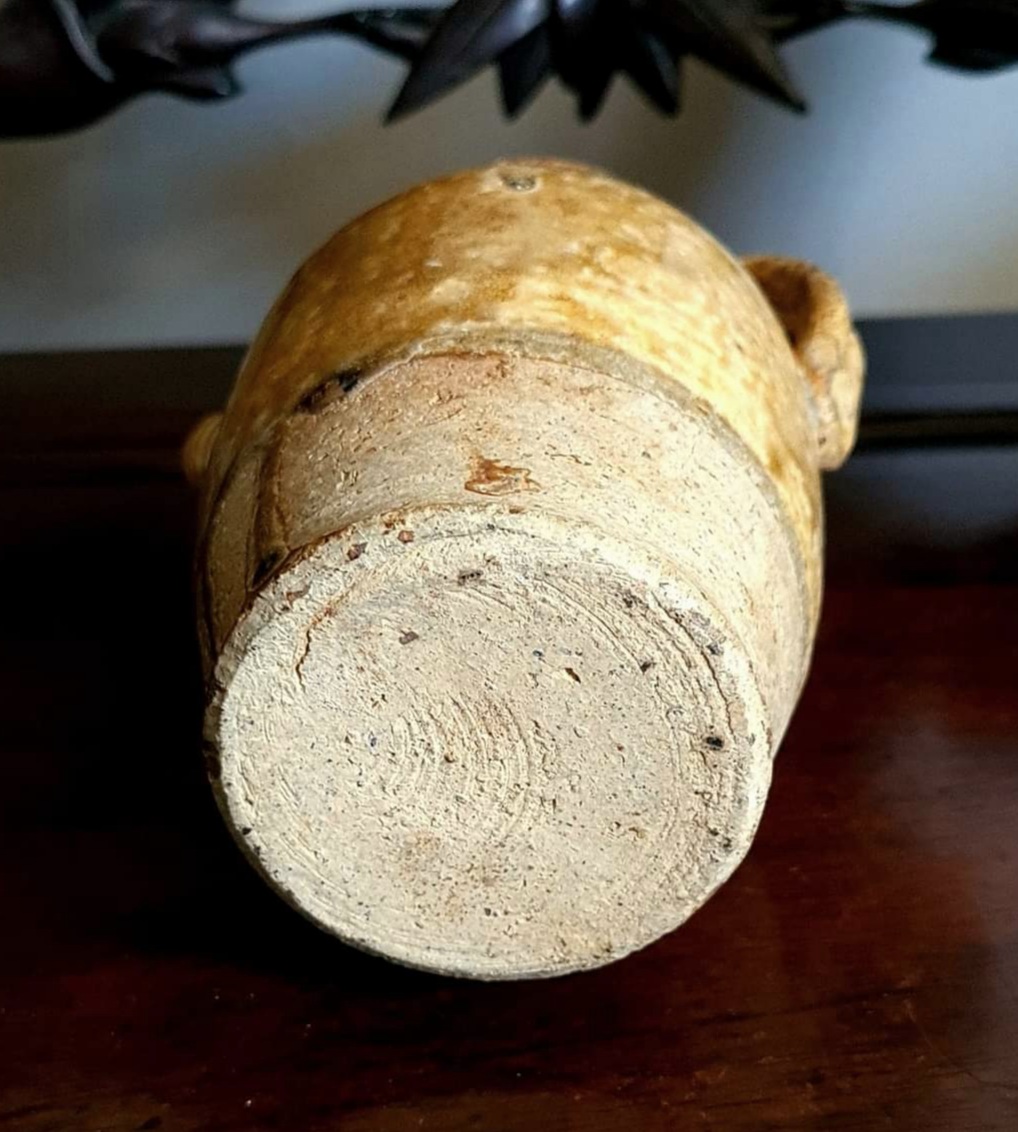 |
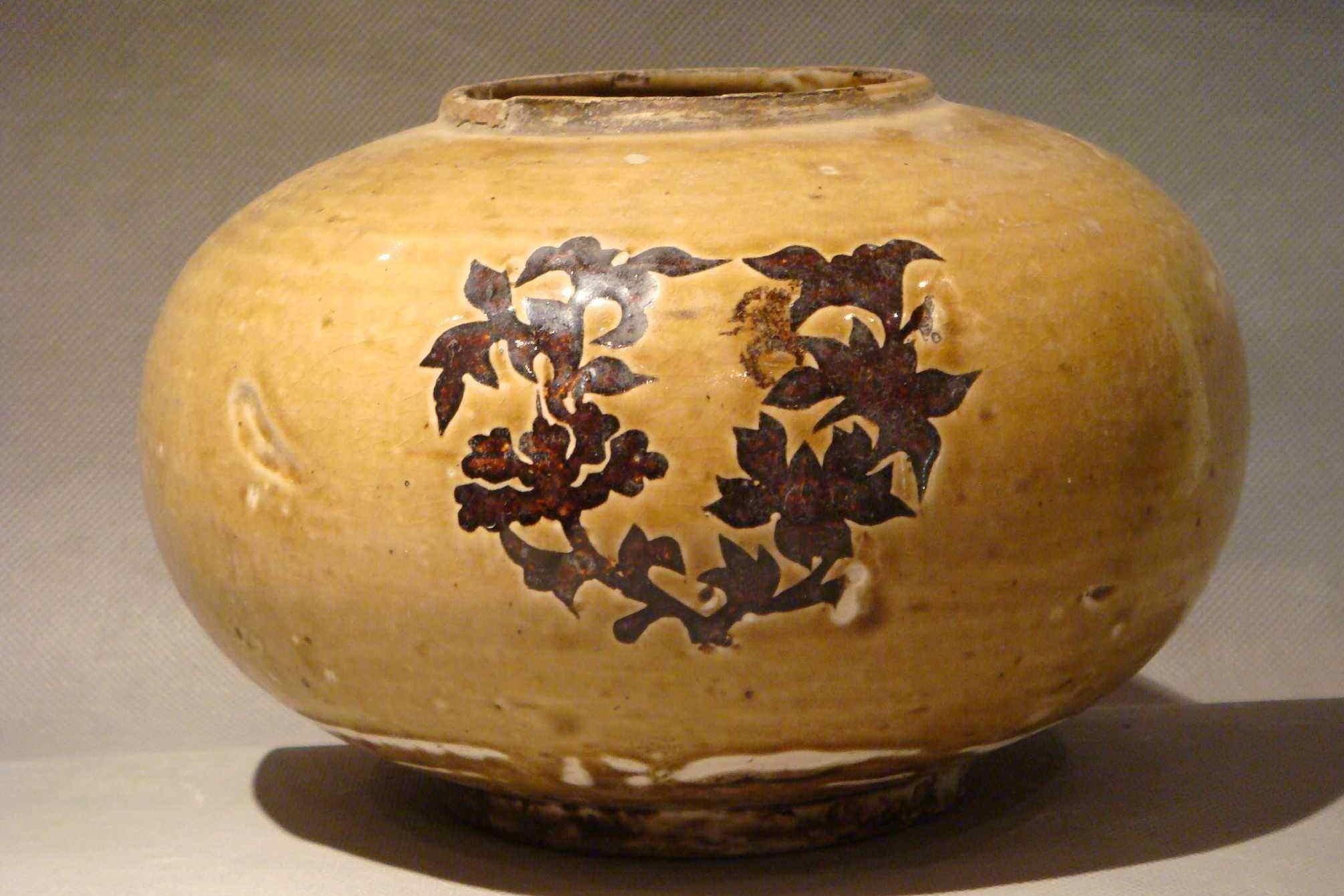 |
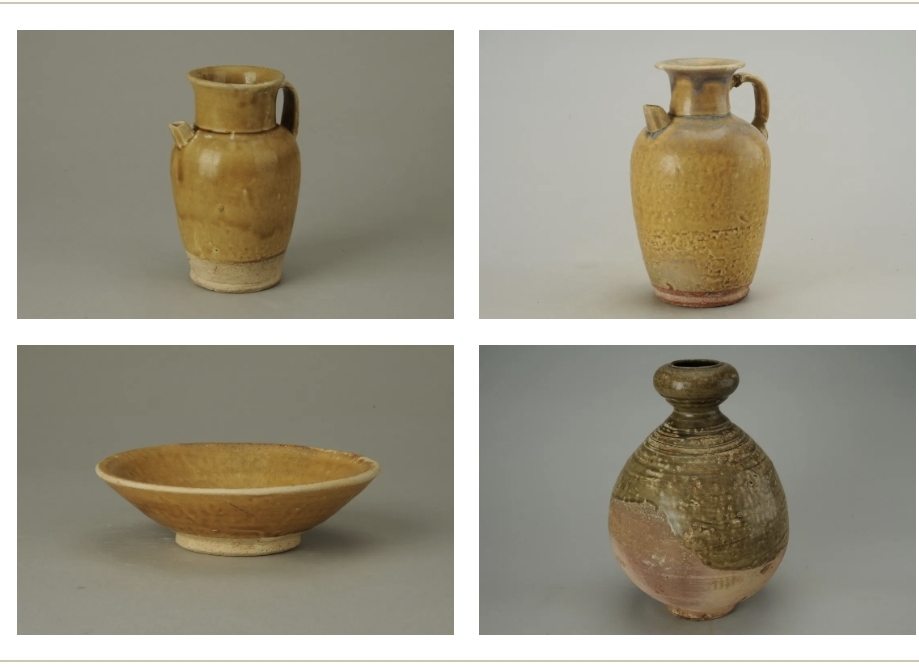 |
| Some examples of Tang Shouzhou wares |
Yuezhou kiln,located in Xiang Yin county (湘阴县) in Hunan,started production during the Han Dynasty. It entered its golden period during the Jin/6 Dynasties period. The glassy glaze has fine crackles and a pleasing greenish colour tone. In comparison, those produced during the Tang dynasty pale in terms of quality.
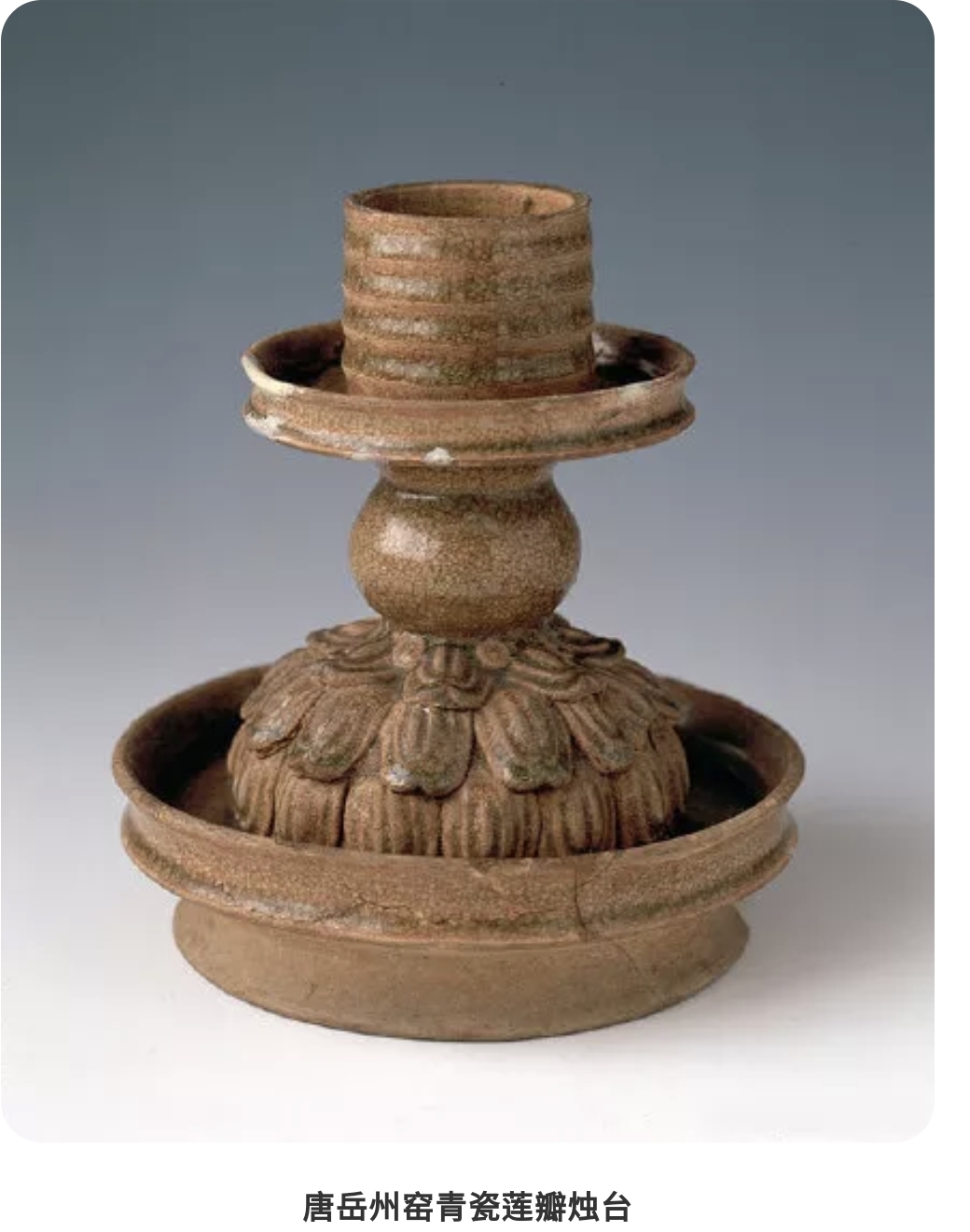 |
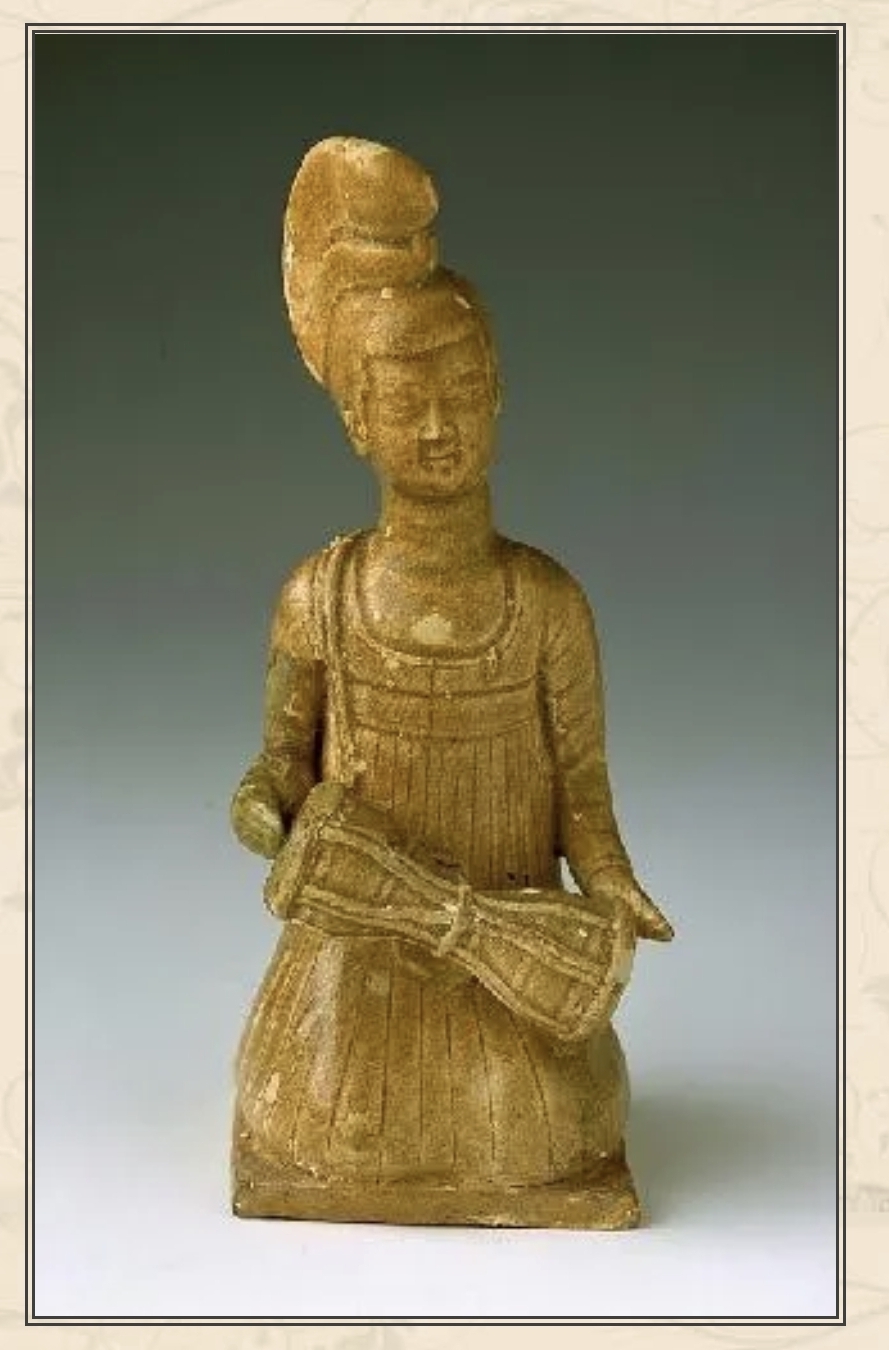 |
| Two Tang examples of Yuezhou ware |
Hongzhou kiln located at Feng cheng (丰城) also started celadon production during the Han dynasty. The paste is coarse and dark brownish or brownish in colour. White slip is applied before glazing. Pre-Tang products generally have a yellowish green glaze. After that, the glaze became more yellowish brown or a sauce brown colour in tone. Products of Hongzhou kiln ranked last in Lu Yu's assesment of their suitability as a vessel for tea drinking. In fact, based on study of the kiln rejects recovered from the archaeological excavations. we can see that the best Hongzhou wares was produced during the 6 Dynasties period.
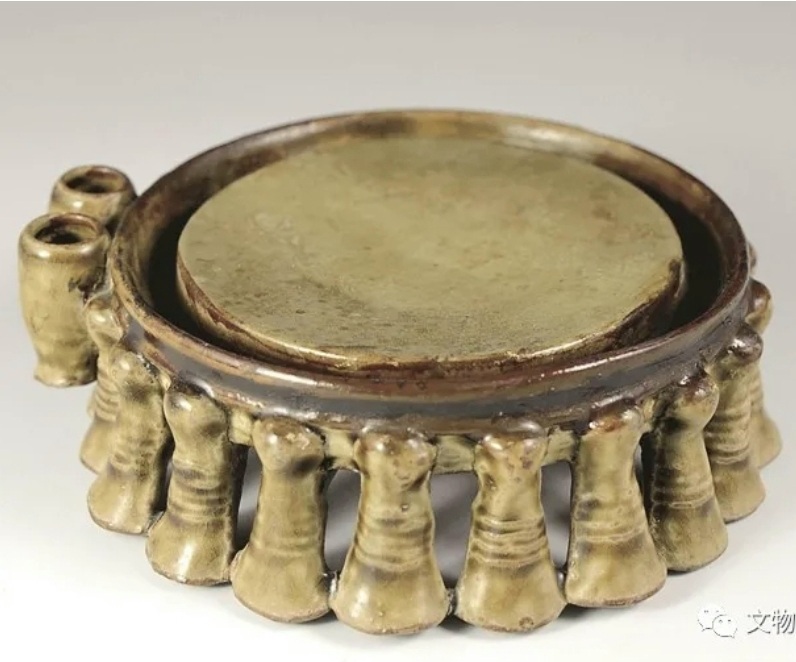 |
|
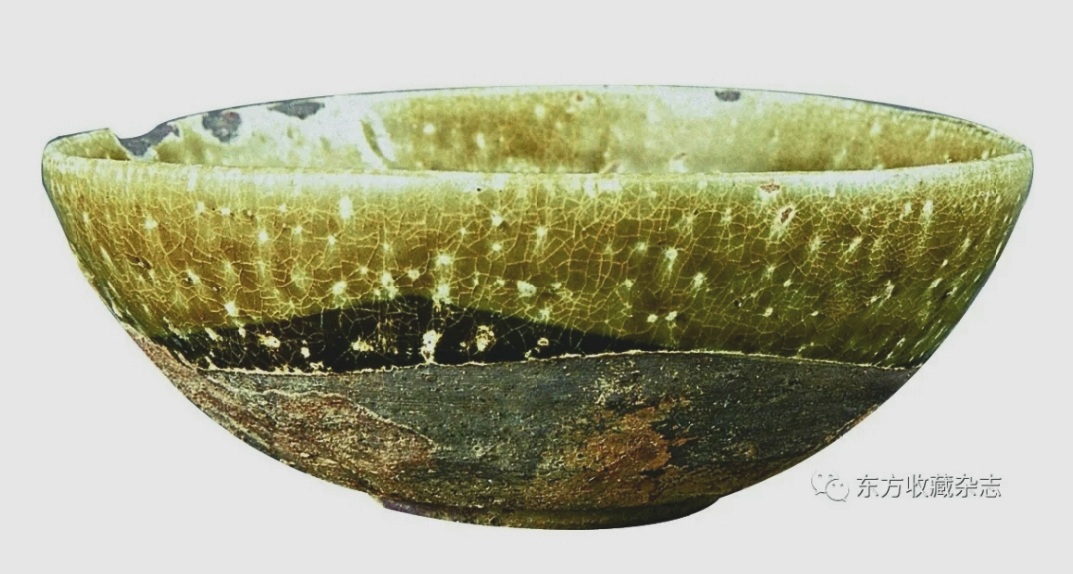 |
|
 |
|
| Tang Hongzhou examples |
Xing white ware
Xing white ware was produced in Hebei Lin cheng(河北临城县)and neiqiu county (内丘县). Xing wares consisted of the fine and coarse type. The fine one has fine grained paste and snow white smooth glaze. The coarse type has more coarse light grayish or buff paste. A layer of white slip was applied and the glaze tends to be grayish white or with tinge of yellow. The most famous Xing ware was the bi base (玉璧底) (solid base with a hole at the centre) bowl commonly know as the samarra type bowl. (It was a popular export ware and found as far as Egypt). Xing ware had a huge market and widely used by the rich and poor. The most common vessels were bowls, plates, hu vases, pillows, guan jars and cover boxes. The bowls were more thinly potted by late Tang and have floral shape.
For more on Xing ware, please read this.
|
|
||
|
|
||
|
|
||
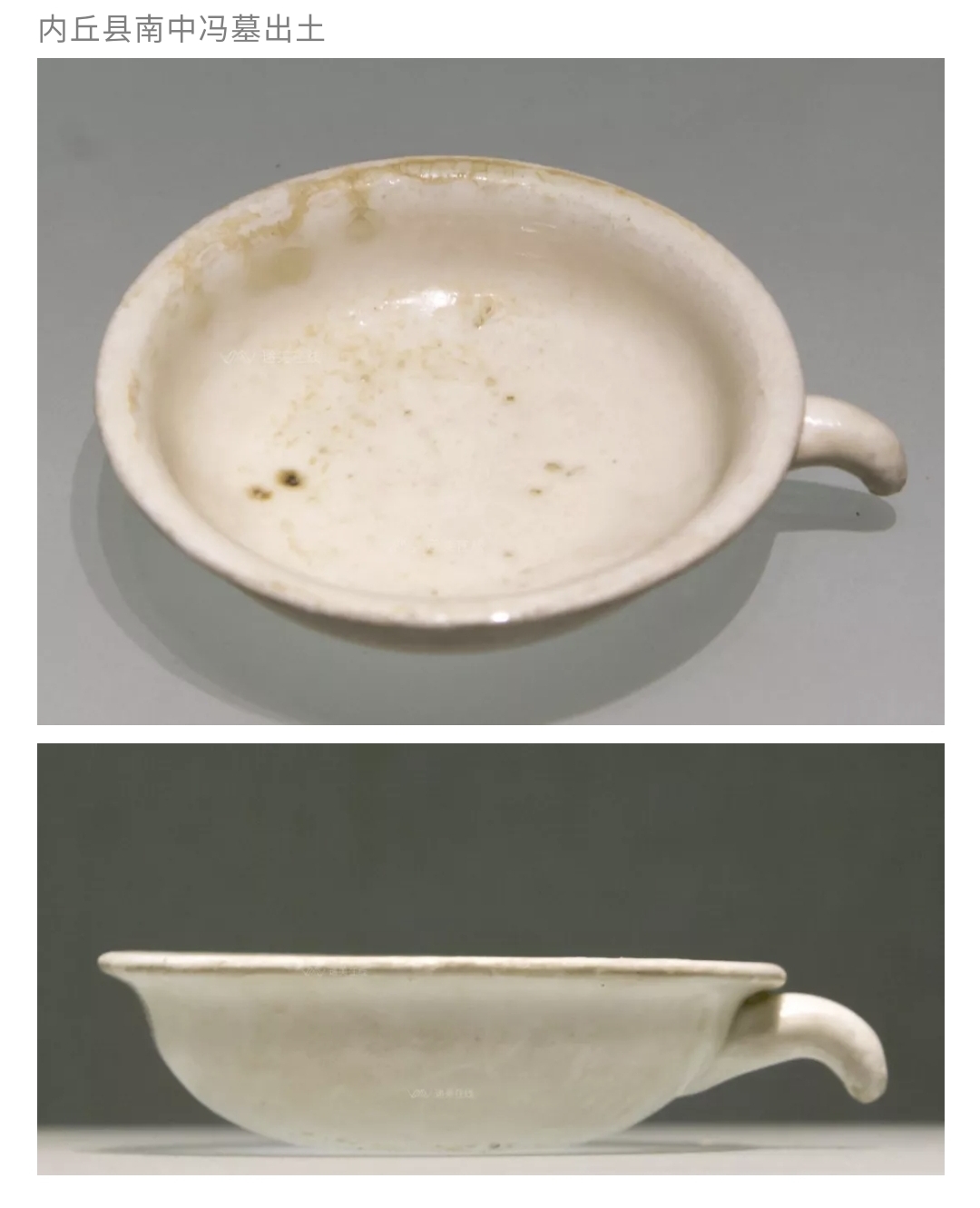 |
||
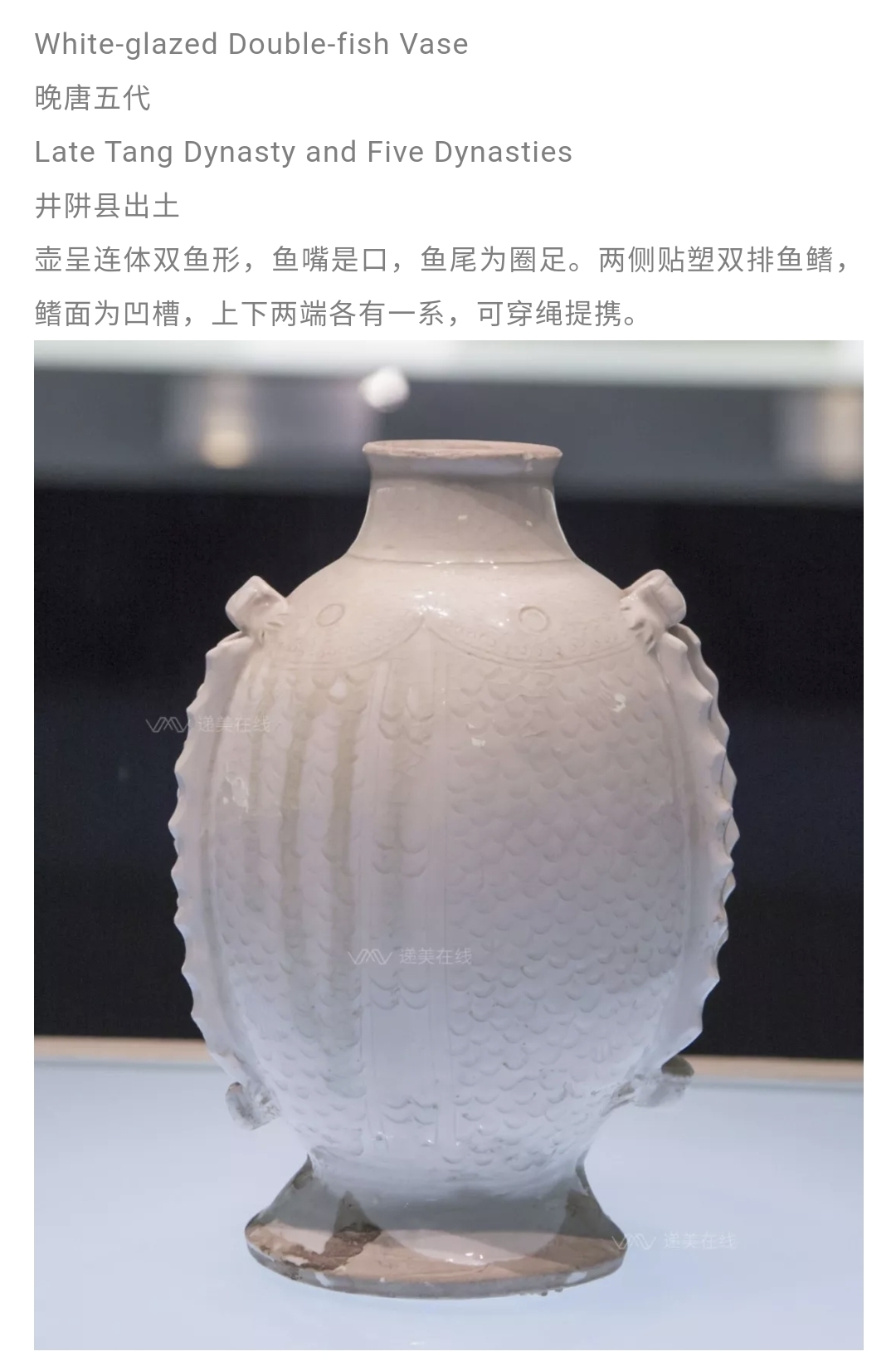 |
||
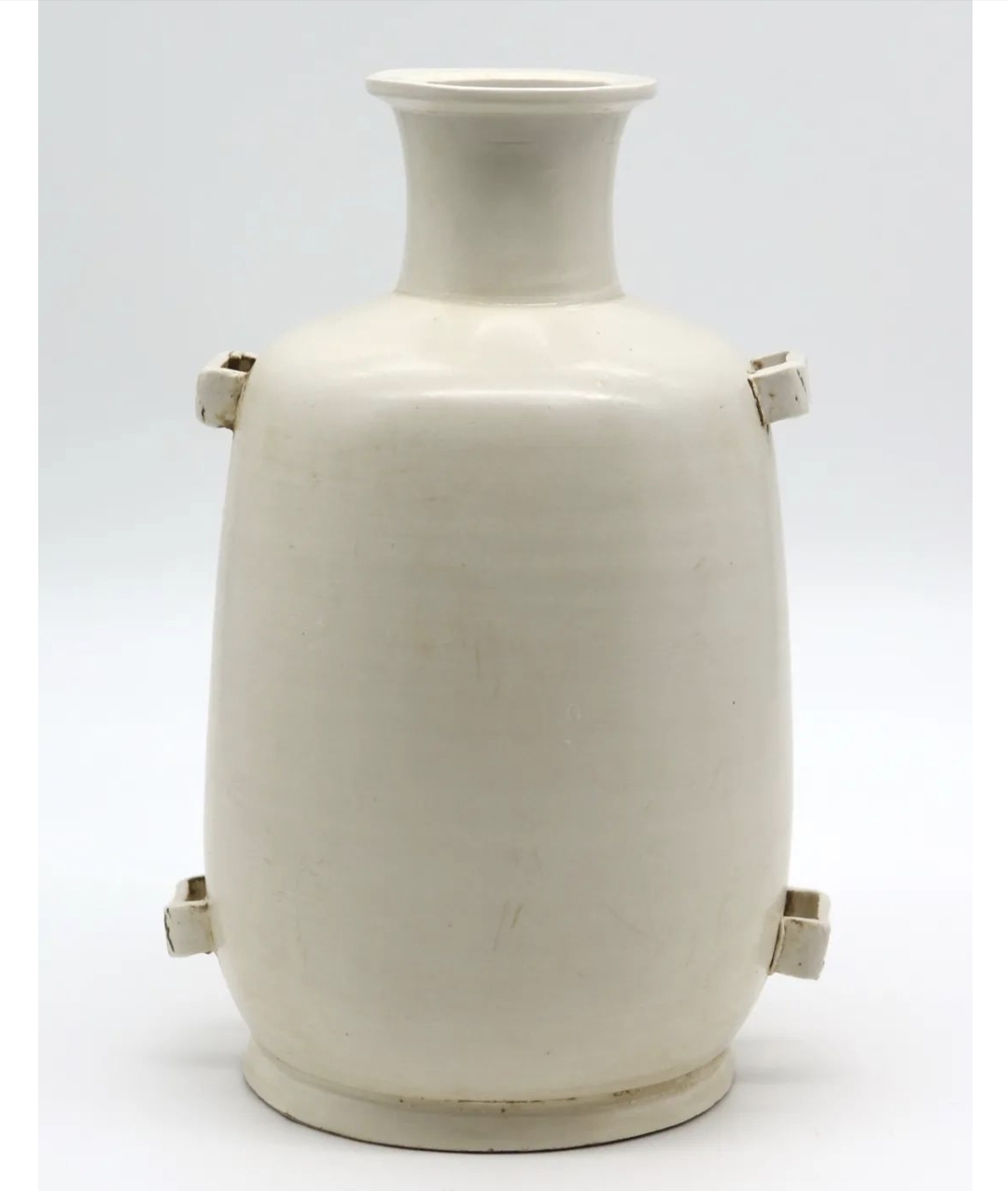 |
||
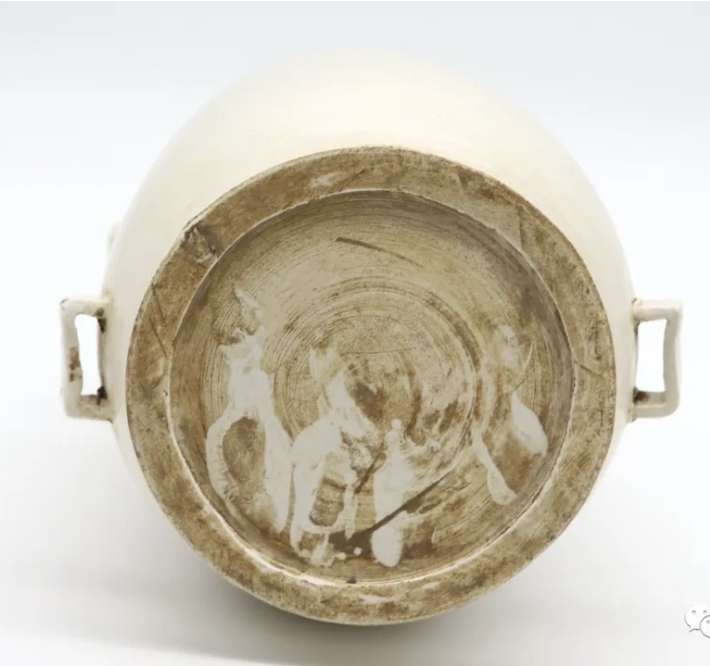 |
||
| Examples of Xing ware | ||
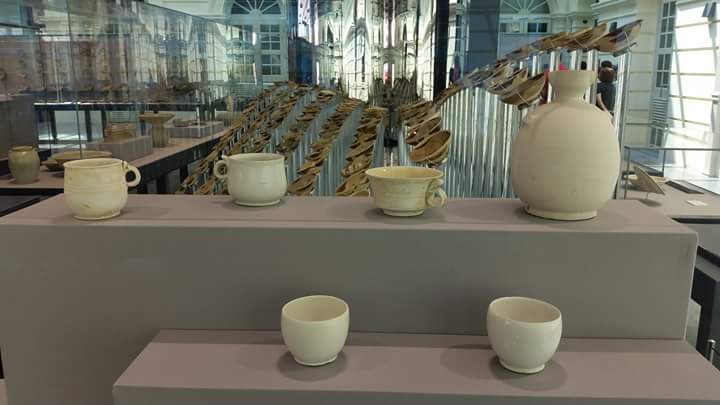 |
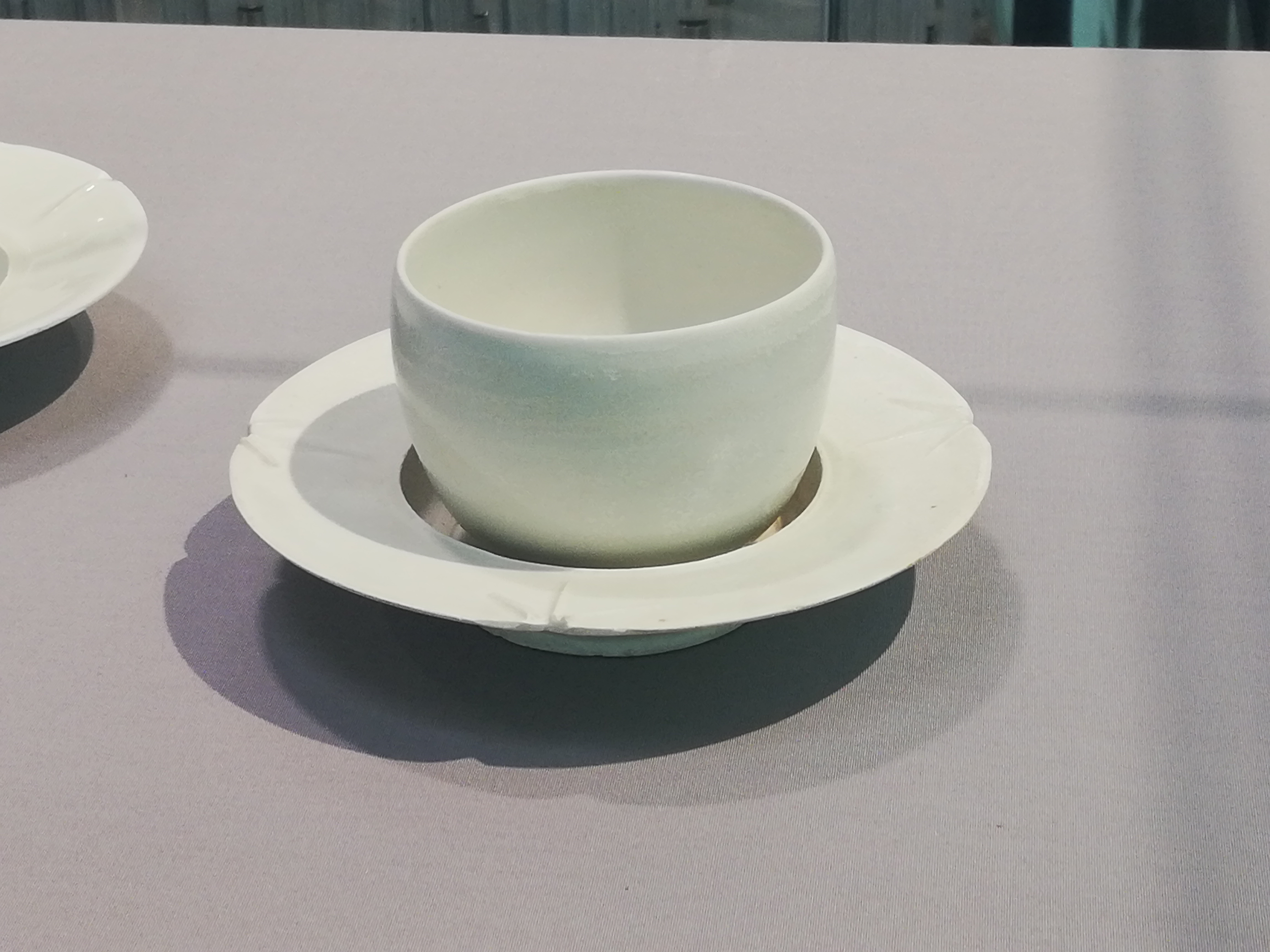 |
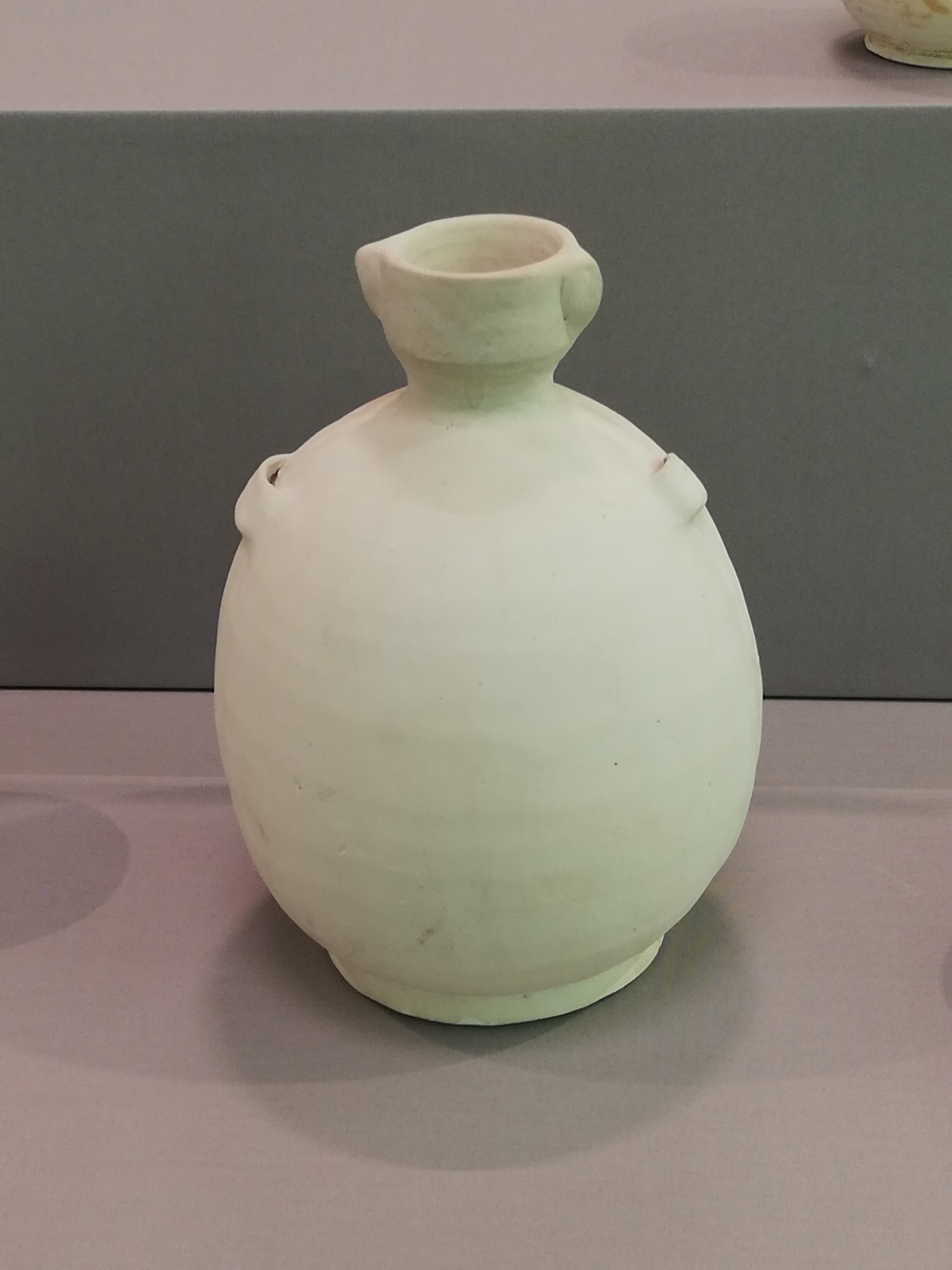 |
| Tang Xing wares from the Belitung wreck |
Tang Gongyi white/blue and white wares
Another famous white ware production site in Northern China was Gongyi 巩义 (previously called gongxian (巩县) in Henan. Gongyi kiln also produced the first underglaze blue and white ware. They were experimental in nature and mainly for the overseas market and production volume was small. The motifs were mainly simplified floral or Islamic geometric form. Some blue and white fragments were excavated from kiln in Gongyi Baihe (巩义白河). 3 known examples were found in the Belitung shipwreck which carried mainly Changsha wares and small quantity of Yue and Xing/gongxian white wares and those with green splashes.

Blue and white dish found in Belitung wreck
Tang White glaze with green splashes/design wares
Some experimental production of lead white glaze wares with green splashes began during the Northern Dynasties. By the Tang Dynasty, there were quite a number of kilns in Henan, Hebei, Shaanxi, Shanxi and Shandong which produced such wares. They were found on vessels such as pillows, bowls, saucers, vases with 5 spouts and etc.
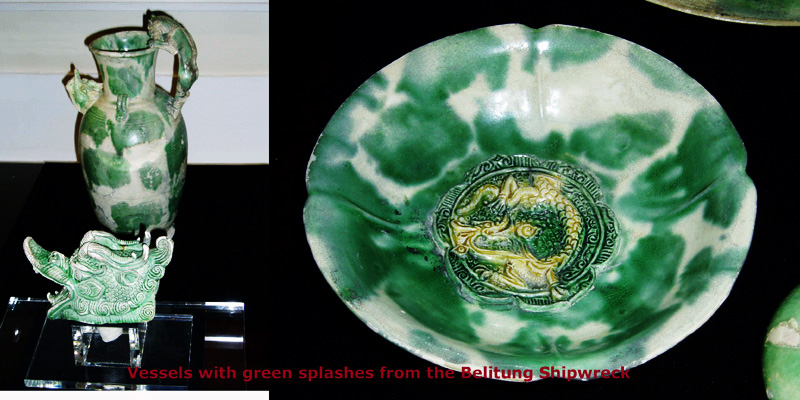
Tang Changsha wares
Changsha kiln ,also termed Tongguan kiln, was a famous Southern China Tang Dynasty kiln. Changsha wares are usually associated with the painted brown and green vessels covered by a straw colour transparent glaze. There were large variety of motifs, such as calligraphy, flowers, fish, children playing, birds, landscape, abstract looking motif and etc . Many of the motifs showed Buddhist and Islamic influence. This was an important development in the history of underglaze painted motifs on porcelain.

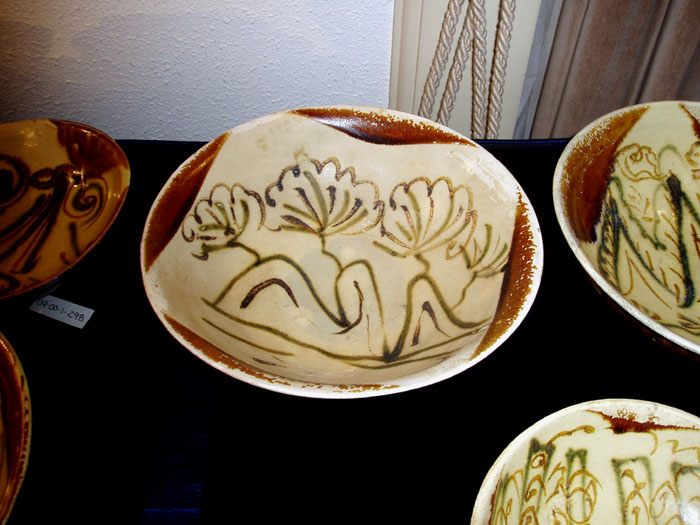
Changsha bowls found in Belitung wreck
Another interesting decorative techniques involved the application of darkish brown glaze, often over the area of molded decorations luted onto ewers. The molded elements included palm like tree, paired birds, lions, human motif, pagoda and etc.
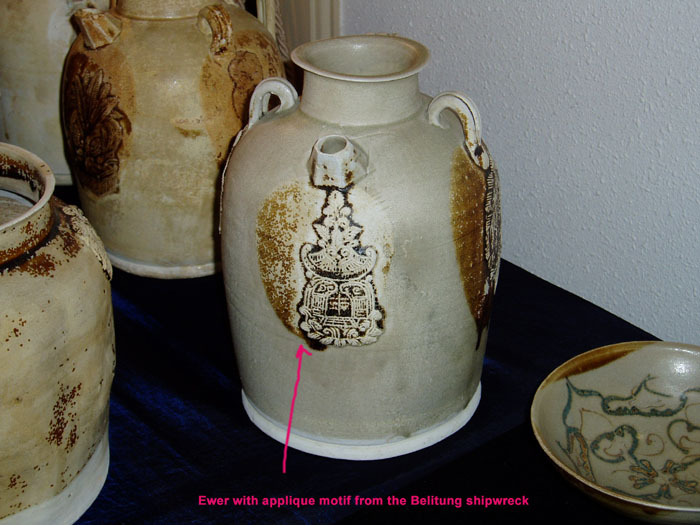
Another important innovation was the use of copper oxide pigment for high fired porcelain. There were some rare examples of vessels with copper red painted or splashed motif.
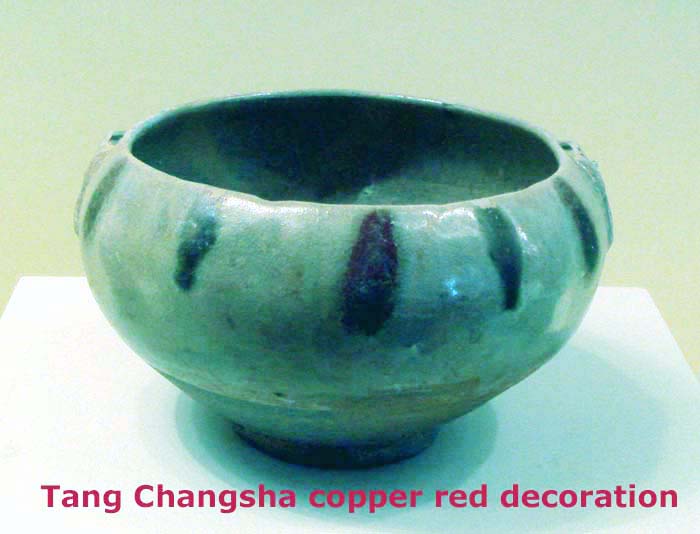
The glaze on Changsha ware is either of a straw colour or a creamy yellowish white. The glaze usually have fine crazings over the surface. The glaze ranges from a bright transparent tone to a somewhat cloudy finish. A white slip is usually applied to conceal the coarse body before the glaze is applied on the vessel. The glaze has a tendency to peel off especially from the areas of a vessel painted brown.
For more information on Changsha ware, please read: Changsha wares
Changsha type porcelains were also produced in Qionglai kilns(邛崃窑)in Shichuan.
Guangdong Green glaze wares
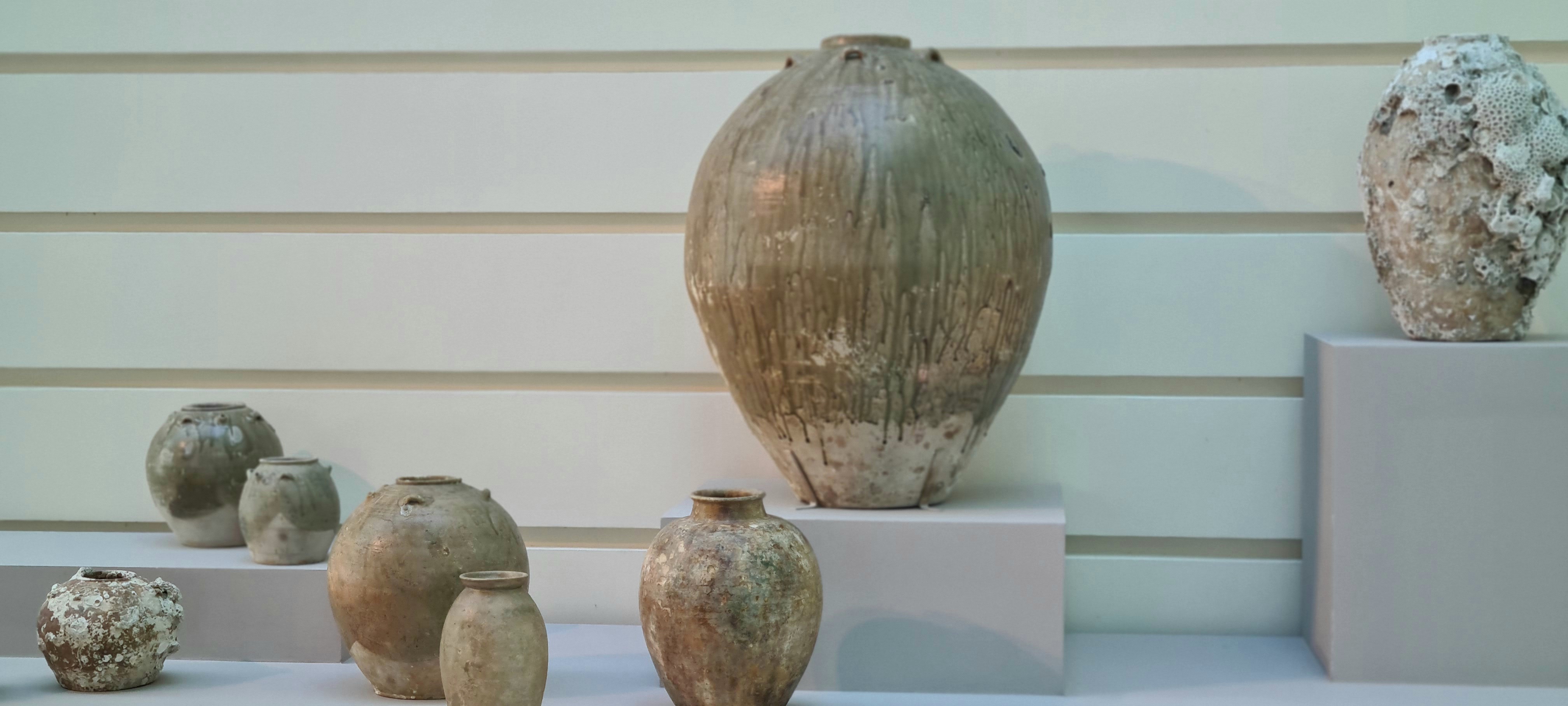 |
| Group of Guangdong green glaze big jars.
Similar types were known to be produced in Xinhui Guanchong and kilns in
the Pearl river Delta Region |
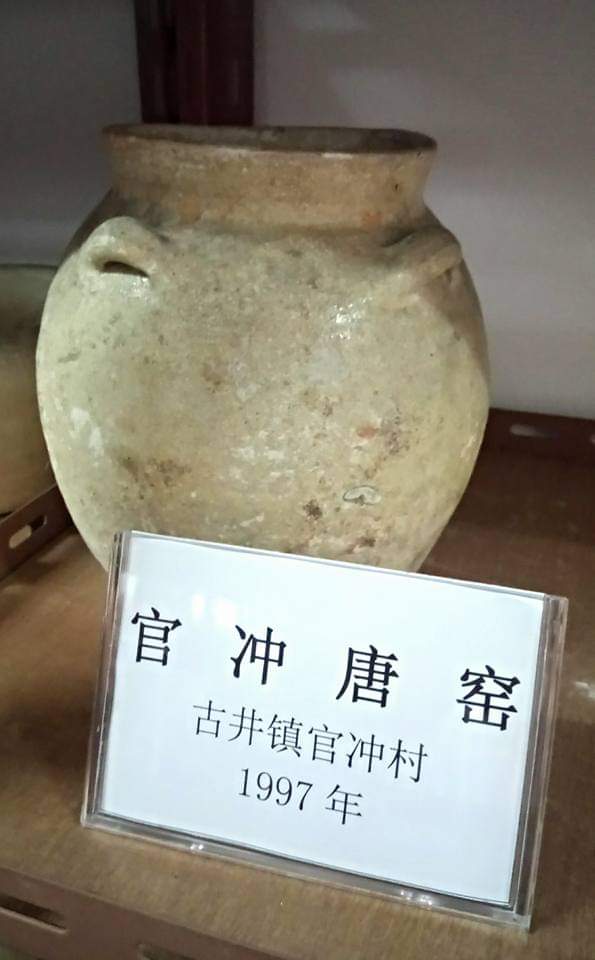 |
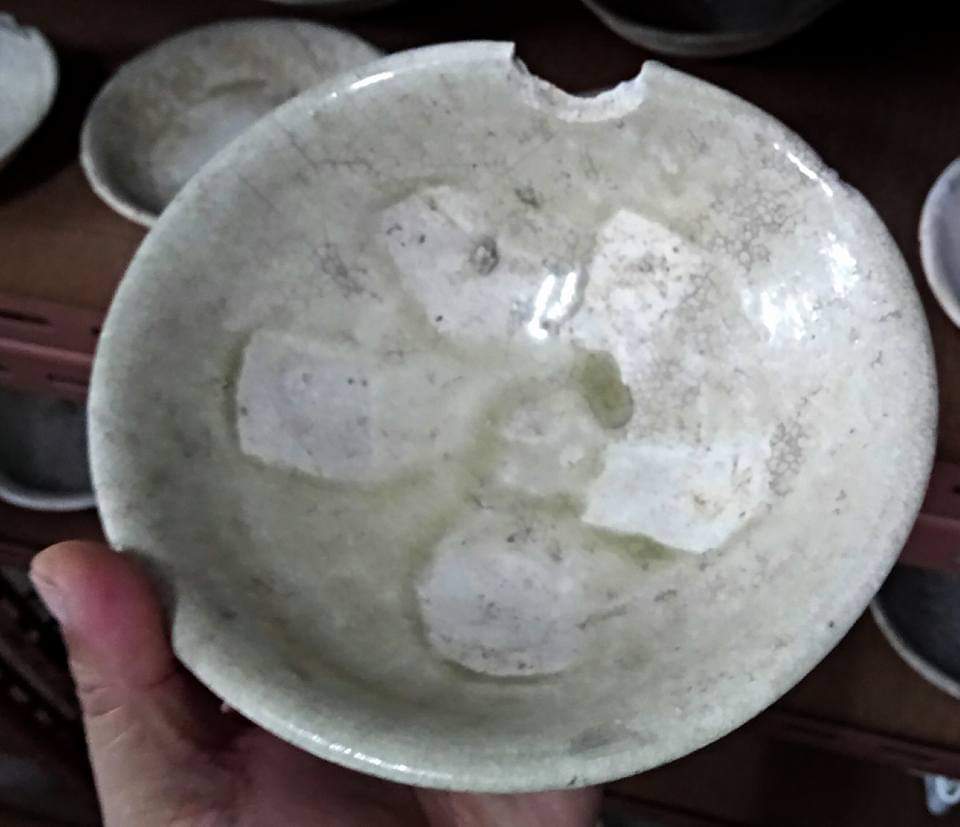 |
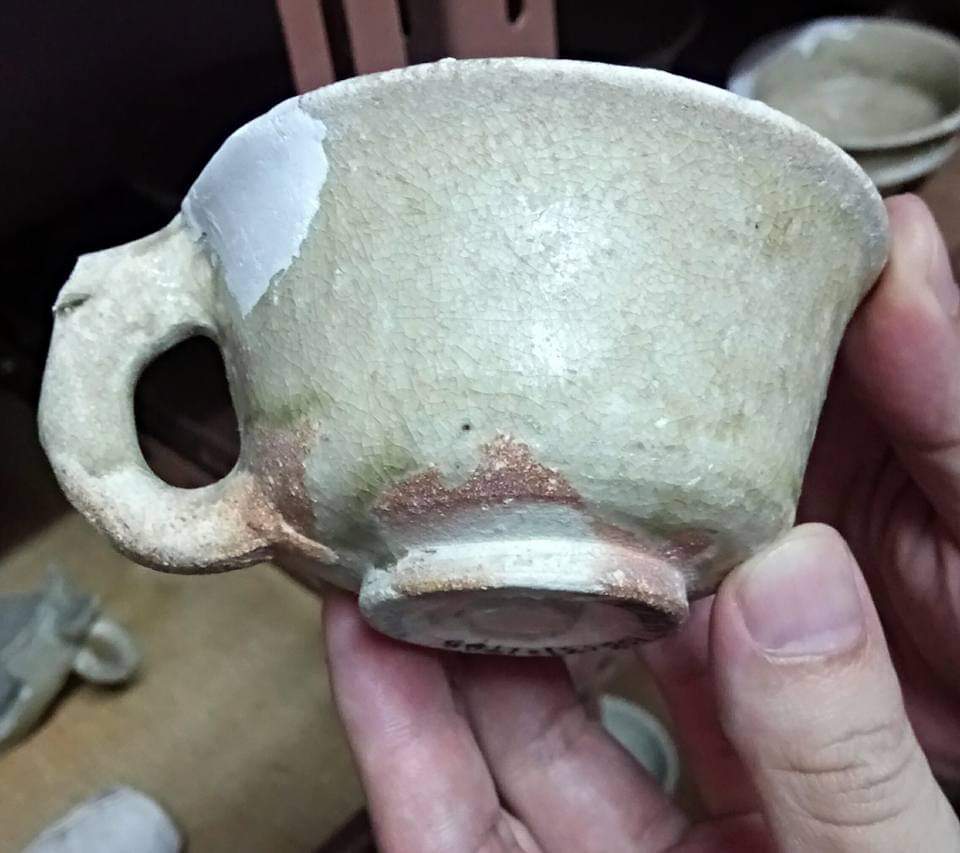 |
| Examples recovered from Xinhui Guanchong kiln |
 |
| Green glaze vessels from the Belitung
wreck. From Mexian Shuiche or Chaozhou kiln. |
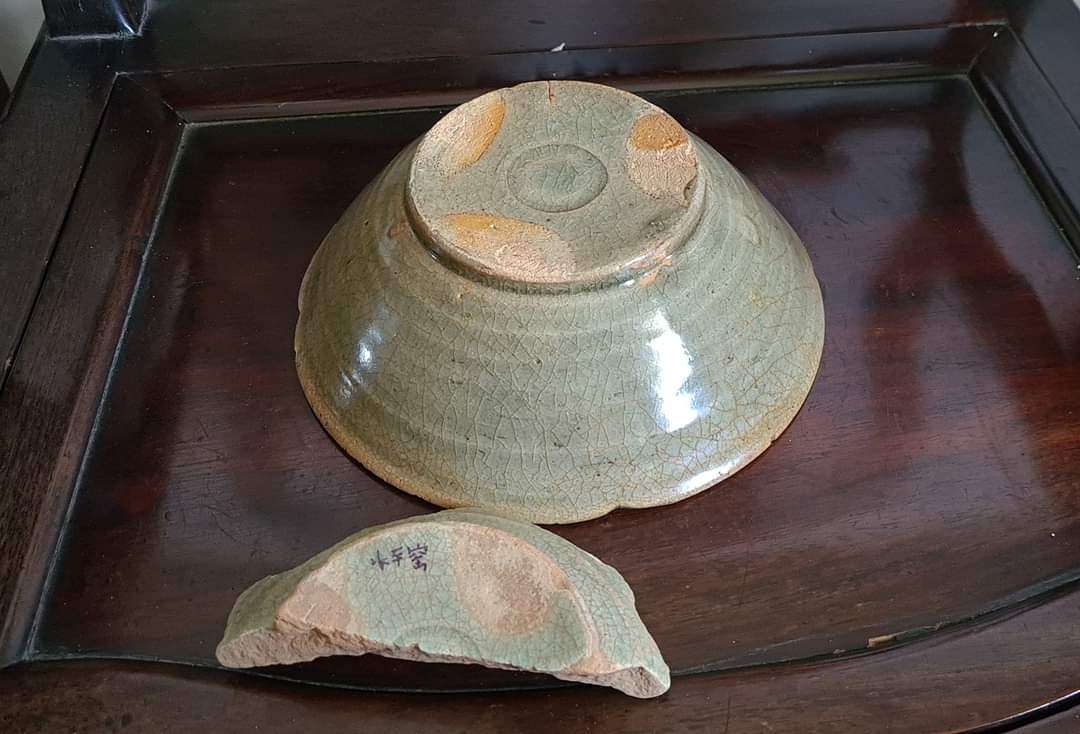 |
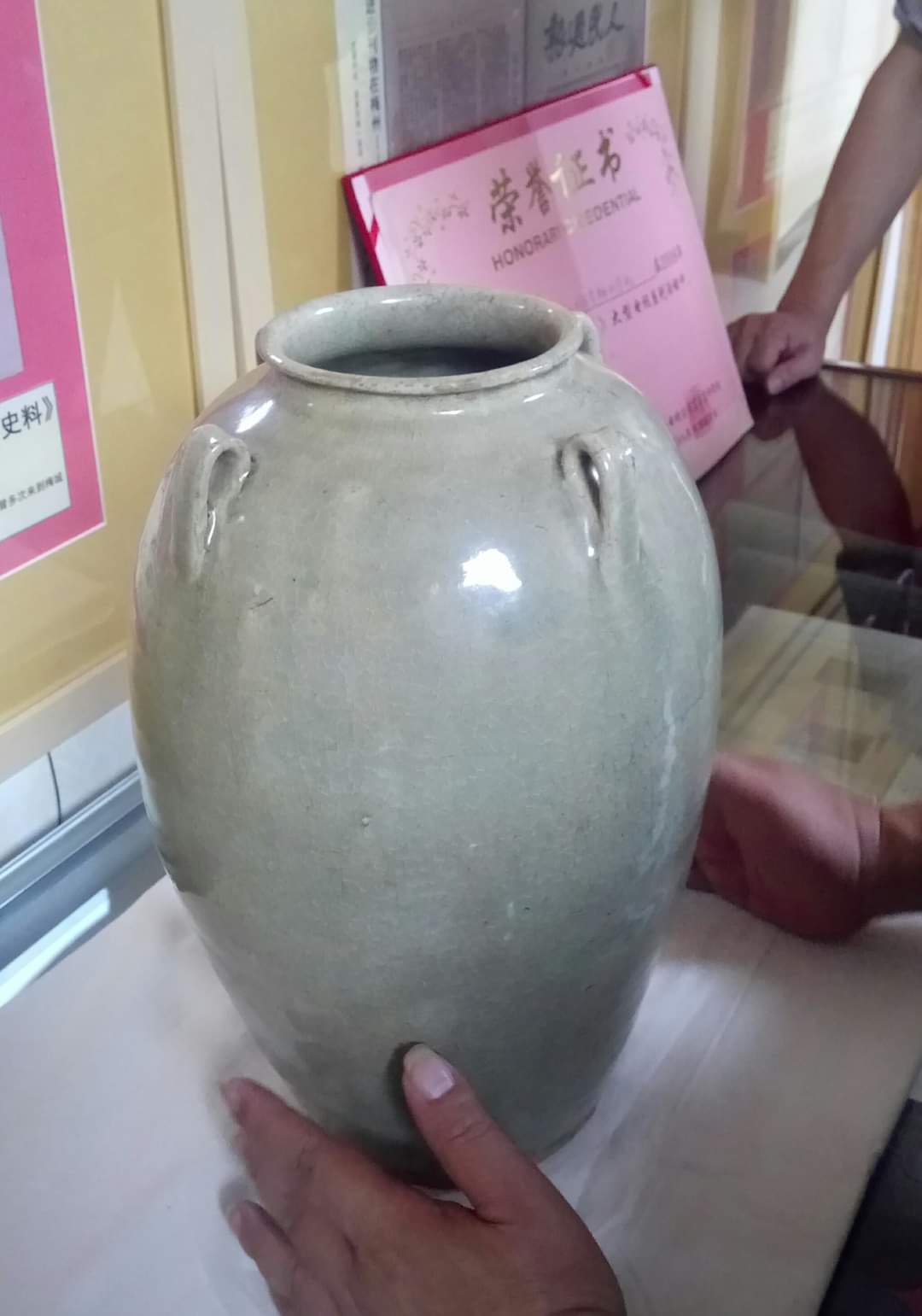 |
| More examples
of Meixian Shuiche kiln green glaze vessels |
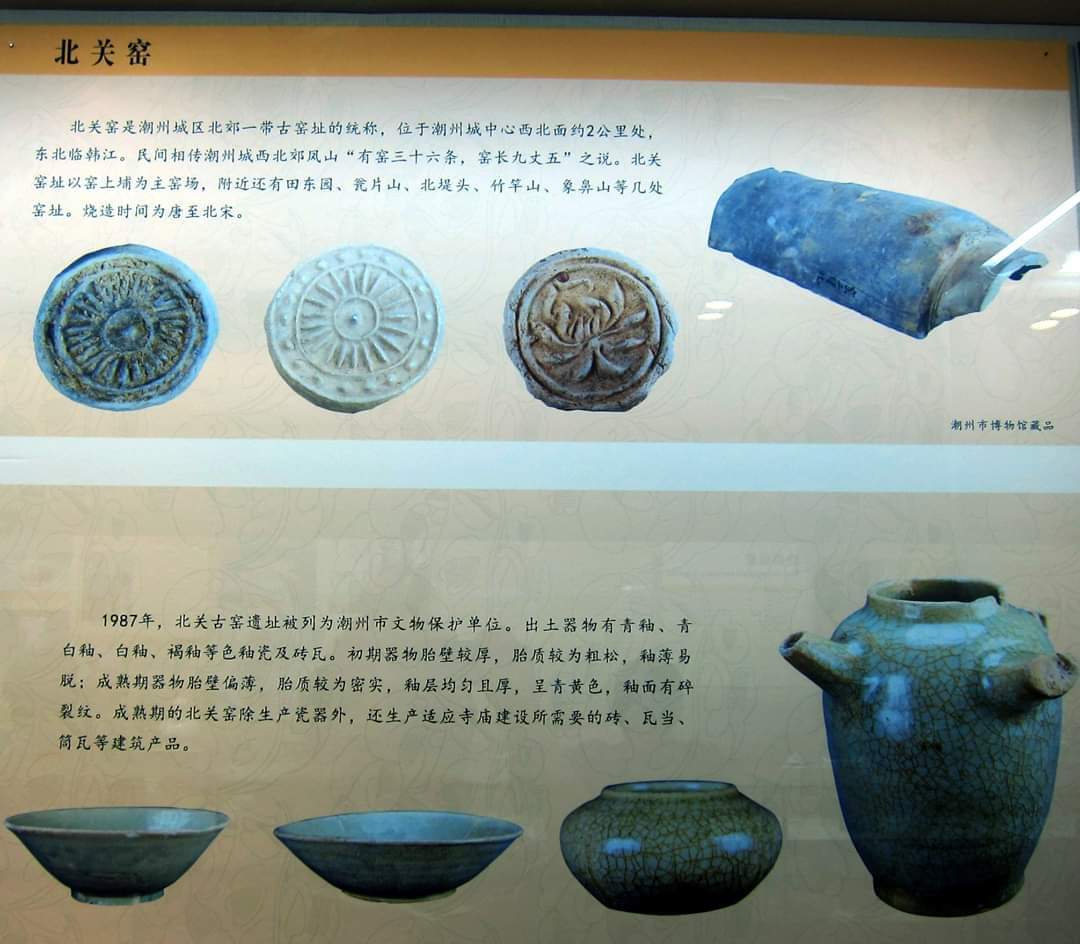 |
| Examples from Chaozou Beiguan kiln. They are similar to those from Meixian and difficult to tell apart. |
Tang Black Glaze with splashes
Many kilns of the period also produced black, brownish black and teadust wares. An interesting variation was the addition of splashes of a whitish or whitish blue glaze over the ground glaze. The Chinese called it hua you (花 釉).Many of the Chinese experts believe such wares were the precursor of Song Jun wares. Typical shapes with such glazes included drum, jar and plates. The most famous kilns producing such wares were Lushan Dudian (鲁山段店窑) and Jiaxian Huangdao (郏县黄道窑). Other kilns which also produced them were Dengfeng Zhudong (登封朱洞窑) and Yuzhou Changzhuang (禹州苌庄窑) and etc.
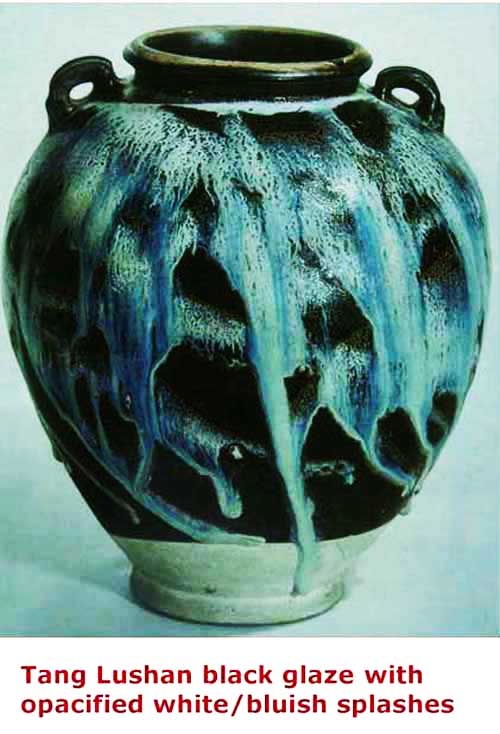
Yaozhou Celadon and black/Teadust ware
Yaozhou kiln also manufactured black /teadust glaze wares during the Tang Dynasty. There were also some with black glaze motif painted over unglaze body of the vessels.
In Northern China Yaozhou, a striking form of greenware with light bluish/greenish glaze were produced from the 5 Dynasty period. Some were decorated with sharply carved motif in relief .

5 Dynasties Anhui Fanchang (安徽繁昌) Qingbai wares
Anhui Fanchang kiln is now widely recognised as one the the earliest sites to produce qingbai wares. The products during the early phase were essentially white glaze wares which inherited the Xing/Ding glazing technology. But sometime later during the 5 Dynasties, the colour of the glaze changed. It showed a more distinct pale bluish tone akin to the Jingdezhen Qingbai glaze. Currently, the earliest known Jingdezhen Qingbai wares were dated to Northern Song and post dated those from Fangchang. In the Chinese academic circle, the view that Fanchang and not Jingdezhen was the pioneer of Qingbai glaze is gaining increasing support.
The main production sites were located in the south, most famous kiln being Ke Chong (柯冲窑) (discovered in the 1950s). They commenced production during the 5 Dynasties period, achieved its golden phase during the early/Mid Northern Song and ceased production by late Northern Song.
In the Java sea Intan wreck cargo, dated to the transition from 5 Dynasties to early Northern Song, there are 3 qingbai cover boxes and 3 dish-mouth ewers. They have physical characteristics which are strikingly similar to those from the Fanchang kilns.
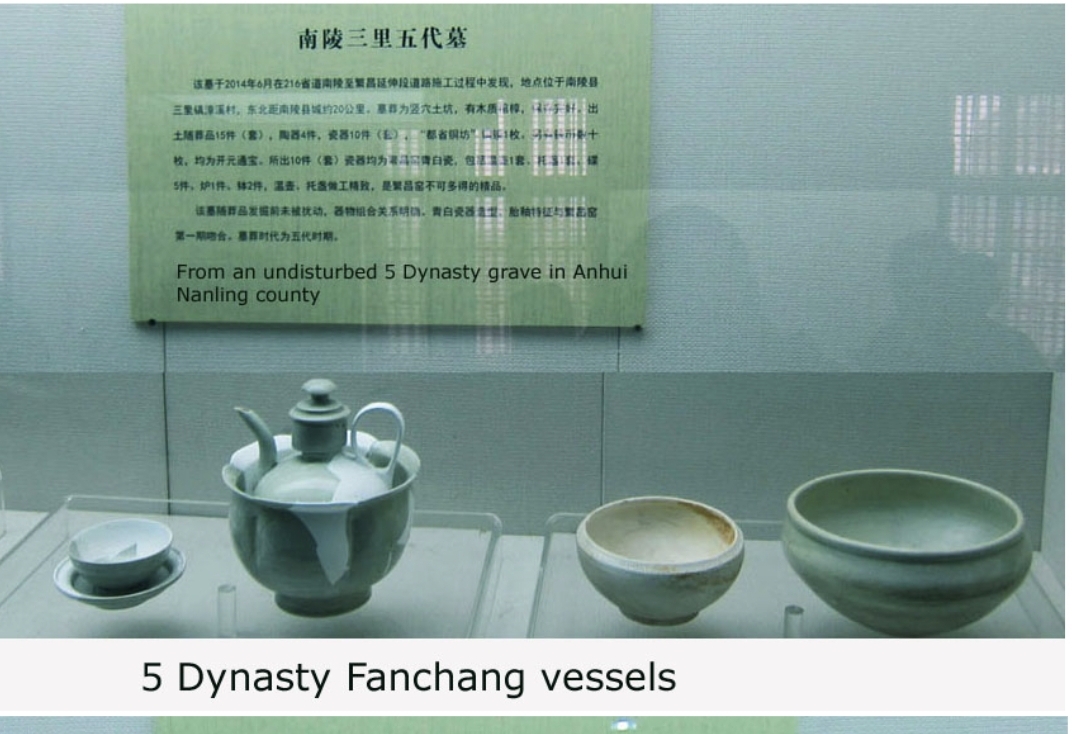
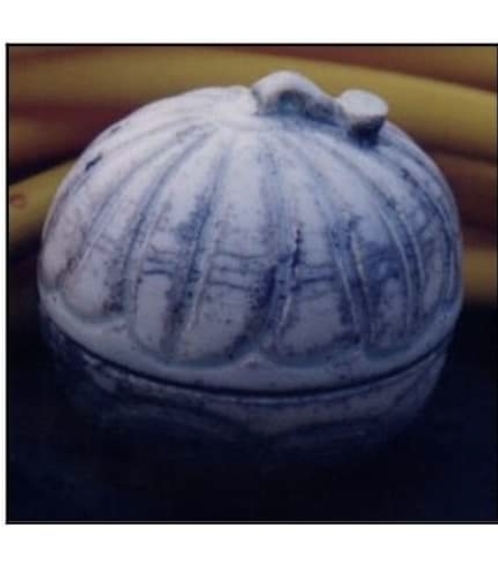 |
 |
| Left cover box from the Intan wreck, Right from Fanchang kiln. | |
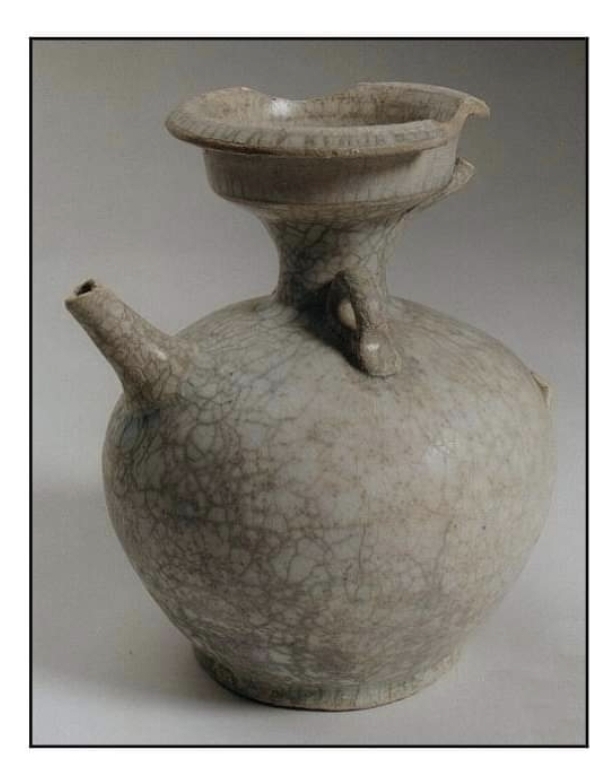 |
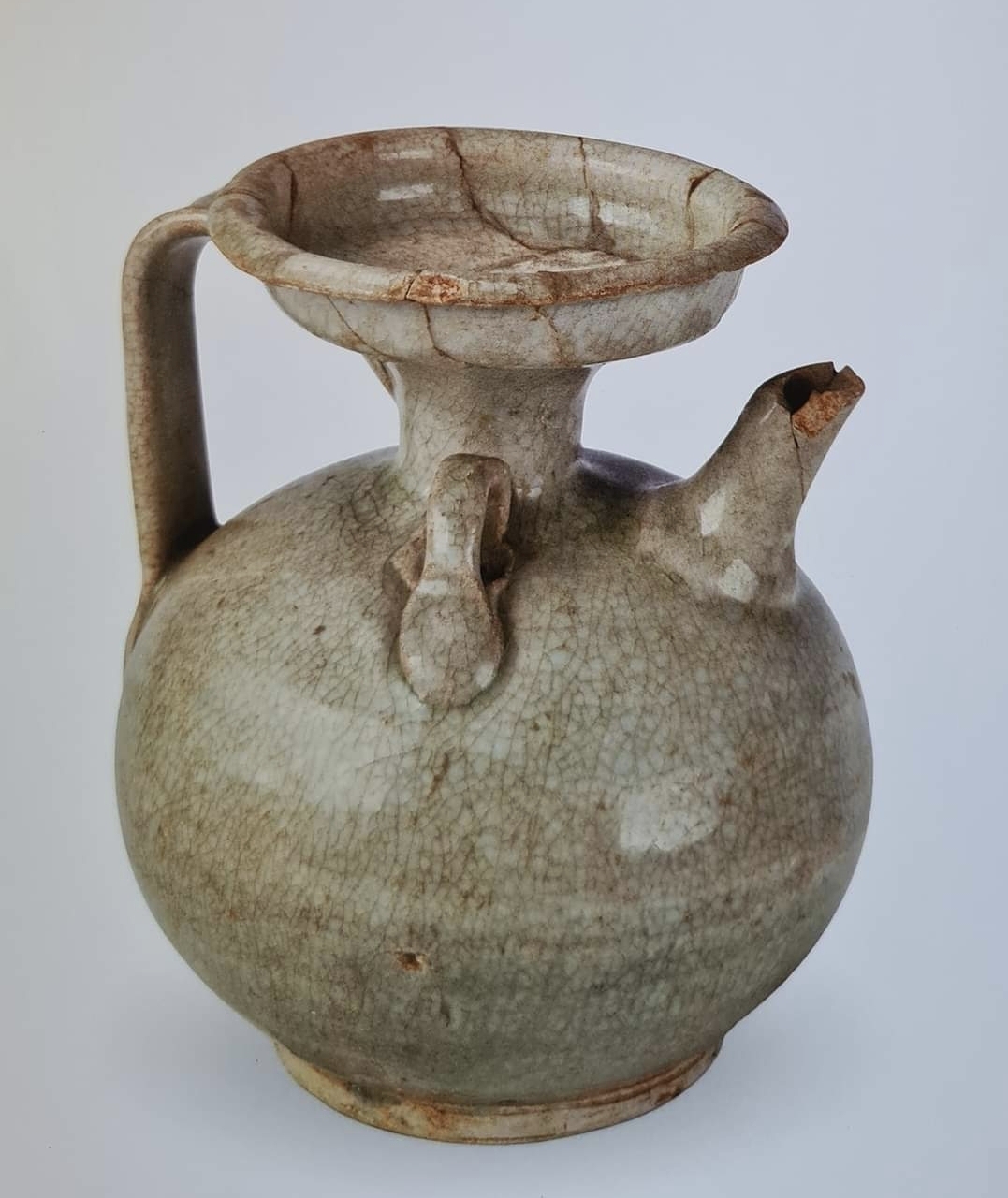 |
| Left ewer from Intan wreck, Right from Fanchang Kiln | |
5 Dynasties Southern China white wares
The kilns making the earliest white wares in Southern China emerged in Jingdezhen during the 5 Dynasties period. The notable ones are Shengmeiting kiln (胜梅亭窑) and shihuwan kiln (石虎弯). Both produced greenware and white wares during the 5 dynasty period and switched to Qingbai production during the Northern Song period. Vessels included ewers, dishes, bowl and basins. They were relatively of fine quality.
Written by : NK Koh (updated 18 Jun 2010, 4 Oct 2021)